Anatomy of a PowerPoint Presentation
The basic building block of a PowerPoint presentation is the slide a block of content the size of a computer screen that typically contains a title, some text, and perhaps a picture or chart. A PowerPoint presentation typically contains many slides.
Figure 1 illustrates a PowerPoint presentation made up of 30 slides. The default (Normal) view includes notes attached to the current slide, and a navigation panel on the left side that allows you to switch between a text outline and slide thumbnails.

Figure 1. PowerPoint's Normal view includes most of the information you need to assemble a presentation.

A fully loaded slide (see Figure 2 ) includes at most six parts:
Figure 2. All the components of a PowerPoint slide are shown here, with slide thumbnails in place of a text outline.

The title, which usually sits at the top of the slide.
Body text, the main part of the slide. More often than not, the text on a slide consists of a series of bulleted or numbered items. However, you can enter any kind of text in this part of a slide bullets and numbers are not required.
Some slides contain content in addition to text. You can add charts, tables, pictures, diagrams, and video clips to help illuminate your presentation.
Text and content sit inside resizable and movable containers called placeholders, which you can see if you click the text or graphic in the slide pane. PowerPoint help screens sometimes refer to the placeholder and the text or content it contains as a "text object" or a "graphic object."
If you choose to display the date and time, these items appear at the lower-left corner by default.
The footer, another optional element, appears by default at the bottom of the slide, in the middle.
Finally, you can choose to display a slide number; its default position is in the lower-right corner.
Most presentations begin with a title slide, which typically includes the title of the presentation, the speaker's name, and other introductory details. If you're planning a presentation as a class project, you might include the class name and number Sociology 101, for instance; for a presentation to a business or civic group, you might include your name and the name of the organization you represent. Other slides in a presentation can also be title slides you might use a title slide to introduce different portions of a long presentation, for example but in most cases, you'll have just one title slide in a presentation, and it will serve as the first slide.
Don't be confused by the terminology. A title slide is, in most cases, a slide that introduces a presentation. A slide title, on the other hand, is usually the first line on a slide.
Critical PowerPoint Shortcuts – Claim Your FREE Training Module and Get Your Time Back!

How to Make a PowerPoint Presentation (Step-by-Step)
- PowerPoint Tutorials
- Presentation Design
- January 22, 2024
In this beginner’s guide, you will learn step-by-step how to make a PowerPoint presentation from scratch.
While PowerPoint is designed to be intuitive and accessible, it can be overwhelming if you’ve never gotten any training on it before. As you progress through this guide, you’ll will learn how to move from blank slides to PowerPoint slides that look like these.

Table of Contents
Additionally, as you create your presentation, you’ll also learn tricks for working more efficiently in PowerPoint, including how to:
- Change the slide order
- Reset your layout
- Change the slide dimensions
- Use PowerPoint Designer
- Format text
- Format objects
- Play a presentation (slide show)
With this knowledge under your belt, you’ll be ready to start creating PowerPoint presentations. Moreover, you’ll have taken your skills from beginner to proficient in no time at all. I will also include links to more advanced PowerPoint topics.
Ready to start learning how to make a PowerPoint presentation?
Take your PPT skills to the next level
Start with a blank presentation.
Note: Before you open PowerPoint and start creating your presentation, make sure you’ve collected your thoughts. If you’re going to make your slides compelling, you need to spend some time brainstorming.
For help with this, see our article with tips for nailing your business presentation here .
The first thing you’ll need to do is to open PowerPoint. When you do, you are shown the Start Menu , with the Home tab open.
This is where you can choose either a blank theme (1) or a pre-built theme (2). You can also choose to open an existing presentation (3).
For now, go ahead and click on the Blank Presentation (1) thumbnail.

Doing so launches a brand new and blank presentation for you to work with. Before you start adding content to your presentation, let’s first familiarize ourselves with the PowerPoint interface.
The PowerPoint interface

Here is how the program is laid out:
- The Application Header
- The Ribbon (including the Ribbon tabs)
- The Quick Access Toolbar (either above or below the Ribbon)
- The Slides Pane (slide thumbnails)
The Slide Area
The notes pane.
- The Status Bar (including the View Buttons)
Each one of these areas has options for viewing certain parts of the PowerPoint environment and formatting your presentation.
Below are the important things to know about certain elements of the PowerPoint interface.
The PowerPoint Ribbon

The Ribbon is contextual. That means that it will adapt to what you’re doing in the program.
For example, the Font, Paragraph and Drawing options are greyed out until you select something that has text in it, as in the example below (A).

Furthermore, if you start manipulating certain objects, the Ribbon will display additional tabs, as seen above (B), with more commands and features to help you work with those objects. The following objects have their own additional tabs in the Ribbon which are hidden until you select them:
- Online Pictures
- Screenshots
- Screen Recording
The Slides Pane

This is where you can preview and rearrange all the slides in your presentation.
Right-clicking on a slide in the pane gives you additional options on the slide level that you won’t find on the Ribbon, such as Duplicate Slide , Delete Slide , and Hide Slide .

In addition, you can add sections to your presentation by right-clicking anywhere in this Pane and selecting Add Section . Sections are extremely helpful in large presentations, as they allow you to organize your slides into chunks that you can then rearrange, print or display differently from other slides.

The Slide Area (A) is where you will build out your slides. Anything within the bounds of this area will be visible when you present or print your presentation.
Anything outside of this area (B) will be hidden from view. This means that you can place things here, such as instructions for each slide, without worrying about them being shown to your audience.

The Notes Pane is the space beneath the Slide Area where you can type in the speaker notes for each slide. It’s designed as a fast way to add and edit your slides’ talking points.
To expand your knowledge and learn more about adding, printing, and exporting your PowerPoint speaker notes, read our guide here .
Your speaker notes are visible when you print your slides using the Notes Pages option and when you use the Presenter View . To expand your knowledge and learn the ins and outs of using the Presenter View , read our guide here .

You can resize the Notes Pane by clicking on its edge and dragging it up or down (A). You can also minimize or reopen it by clicking on the Notes button in the Status Bar (B).
Note: Not all text formatting displays in the Notes Pane, even though it will show up when printing your speaker notes. To learn more about printing PowerPoint with notes, read our guide here .
Now that you have a basic grasp of the PowerPoint interface at your disposal, it’s time to make your presentation.
Adding Content to Your PowerPoint Presentation
Notice that in the Slide Area , there are two rectangles with dotted outlines. These are called Placeholders and they’re set on the template in the Slide Master View .
To expand your knowledge and learn how to create a PowerPoint template of your own (which is no small task), read our guide here .

As the prompt text suggests, you can click into each placeholder and start typing text. These types of placeholder prompts are customizable too. That means that if you are using a company template, it might say something different, but the functionality is the same.

Note: For the purposes of this example, I will create a presentation based on the content in the Starbucks 2018 Global Social Impact Report, which is available to the public on their website.
If you type in more text than there is room for, PowerPoint will automatically reduce its font size. You can stop this behavior by clicking on the Autofit Options icon to the left of the placeholder and selecting Stop Fitting Text to this Placeholder .
Next, you can make formatting adjustments to your text by selecting the commands in the Font area and the Paragraph area of the Home tab of the Ribbon.

The Reset Command: If you make any changes to your title and decide you want to go back to how it was originally, you can use the Reset button up in the Home tab .

Insert More Slides into Your Presentation
Now that you have your title slide filled in, it’s time to add more slides. To do that, simply go up to the Home tab and click on New Slide . This inserts a new slide in your presentation right after the one you were on.

You can alternatively hit Ctrl+M on your keyboard to insert a new blank slide in PowerPoint. To learn more about this shortcut, see my guide on using Ctrl+M in PowerPoint .
Instead of clicking the New Slide command, you can also open the New Slide dropdown to see all the slide layouts in your PowerPoint template. Depending on who created your template, your layouts in this dropdown can be radically different.

If you insert a layout and later want to change it to a different layout, you can use the Layout dropdown instead of the New Slide dropdown.
After inserting a few different slide layouts, your presentation might look like the following picture. Don’t worry that it looks blank, next we will start adding content to your presentation.

If you want to follow along exactly with me, your five slides should be as follows:
- Title Slide
- Title and Content
- Section Header
- Two Content
- Picture with Caption
Adding Content to Your Slides
Now let’s go into each slide and start adding our content. You’ll notice some new types of placeholders.

On slide 2 we have a Content Placeholder , which allows you to add any kind of content. That includes:
- A SmartArt graphic,
- A 3D object,
- A picture from the web,
- Or an icon.
To insert text, simply type it in or hit Ctrl+C to Copy and Ctrl+V to Paste from elsewhere. To insert any of the other objects, click on the appropriate icon and follow the steps to insert it.
For my example, I’ll simply type in some text as you can see in the picture below.

Slides 3 and 4 only have text placeholders, so I’ll go ahead and add in my text into each one.

On slide 5 we have a Picture Placeholder . That means that the only elements that can go into it are:
- A picture from the web

To insert a picture into the picture placeholder, simply:
- Click on the Picture icon
- Find a picture on your computer and select it
- Click on Insert
Alternatively, if you already have a picture open somewhere else, you can select the placeholder and paste in (shortcut: Ctrl+V ) the picture. You can also drag the picture in from a file explorer window.

If you do not like the background of the picture you inserted onto your slide, you can remove the background here in PowerPoint. To see how to do this, read my guide here .
Placeholders aren’t the only way to add content to your slides. At any point, you can use the Insert tab to add elements to your slides.
You can use either the Title Only or the Blank slide layout to create slides for content that’s different. For example, a three-layout content slide, or a single picture divider slide, as shown below.

In the first example above, I’ve inserted 6 text boxes, 3 icons, and 3 circles to create this layout. In the second example, I’ve inserted a full-sized picture and then 2 shapes and 2 text boxes.
The Reset Command: Because these slides are built with shapes and text boxes (and not placeholders), hitting the Reset button up in the Home tab won’t do anything.
That is a good thing if you don’t want your layouts to adjust. However, it does mean that it falls on you to make sure everything is aligned and positioned correctly.
For more on how to add and manipulate the different objects in PowerPoint, check out our step-by-step articles here:
- Using graphics in PowerPoint
- Inserting icons onto slides
- Adding pictures to your PowerPoint
- How to embed a video in PowerPoint
- How to add music to your presentation
Using Designer to generate more layouts ideas
If you have Office 365, your version of PowerPoint comes with a new feature called Designer (or Design Ideas). This is a feature that generates slide layout ideas for you. The coolest thing about this feature is that it uses the content you already have.
To use Designer , simply navigate to the Design tab in your Ribbon, and click on Design Ideas .

NOTE: If the PowerPoint Designer is not working for you (it is grey out), see my troubleshooting guide for Designer .
Change the Overall Design (optional)
When you make a PowerPoint presentation, you’ll want to think about the overall design. Now that you have some content in your presentation, you can use the Design tab to change the look and feel of your slides.
For additional help thinking through the design of your presentation, read my guide here .
A. Picking your PowerPoint slide size
If you have PowerPoint 2013 or later, when you create a blank document in PowerPoint, you automatically start with a widescreen layout with a 16:9 ratio. These dimensions are suitable for most presentations as they match the screens of most computers and projectors.
However, you do have the option to change the dimensions.
For example, your presentation might not be presented, but instead converted into a PDF or printed and distributed. In that case, you can easily switch to the standard dimensions with a 4:3 ratio by selecting from the dropdown (A).
You can also choose a custom slide size or change the slide orientation from landscape to portrait in the Custom Slide Size dialog box (B).

To learn all about the different PowerPoint slide sizes, and some of the issues you will face when changing the slide size of a non-blank presentation, read my guide here .
B. Selecting a PowerPoint theme
The next thing you can do is change the theme of your presentation to a pre-built one. For a detailed explanation of what a PowerPoint theme is, and how to best use it, read my article here .
In the beginning of this tutorial, we started with a blank presentation, which uses the default Office theme as you can see in the picture below.

That gives you the most flexibility because it has a blank background and quite simple layouts that work for most presentations. However, it also means that it’s your responsibility to enhance the design.
If you’re comfortable with this, you can stay with the default theme or create your own custom theme ( read my guide here ). But if you would rather not have to think about design, then you can choose a pre-designed theme.
Microsoft provides 46 other pre-built themes, which include slide layouts, color variants and palettes, and fonts. Each one varies quite significantly, so make sure you look through them carefully.
To select a different theme, go to the Design tab in the Ribbon, and click on the dropdown arrow in the Themes section .

For this tutorial, let’s select the Frame theme and then choose the third Variant in the theme. Doing so changes the layout, colors, and fonts of your presentation.

Note: The theme dropdown area is also where you can import or save custom themes. To see my favorite places to find professional PowerPoint templates and themes (and recommendations for why I like them), read my guide here .
C. How to change a slide background in PowerPoint
The next thing to decide is how you want your background to look for the entire presentation. In the Variants area, you can see four background options.

For this example, we want our presentation to have a dark background, so let’s select Style 3. When you do so, you’ll notice that:
- The background color automatically changes across all slides
- The color of the text on most of the slides automatically changes to white so that it’s visible on the dark background
- The colors of the objects on slides #6 and #7 also adjust, in a way we may not want (we’ll likely have to make some manual adjustments to these slides)

Note: If you want to change the slide background for just that one slide, don’t left-click the style. Instead, right-click it and select Apply to Selected Slides .
After you change the background for your entire presentation, you can easily adjust the background for an individual slide.

Inside the Format Background pane, you can see you have the following options:
- Gradient fill
- Picture or texture fill
- Pattern fill
- Hide background
You can explore these options to find the PowerPoint background that best fits your presentation.
D. How to change your color palette in PowerPoint
Another thing you may want to adjust in your presentation, is the color scheme. In the picture below you can see the Theme Colors we are currently using for this presentation.

Each PowerPoint theme comes with its own color palette. By default, the Office theme includes the Office color palette. This affects the colors you are presented with when you format any element within your presentation (text, shapes, SmartArt, etc.).

The good news is that the colors here are easy to change. To switch color palettes, simply:
- Go to the Design tab in the Ribbon
- In the Variants area, click on the dropdown arrow and select Colors
- Select the color palette (or theme colors) you want
You can choose among the pre-built color palettes from Office, or you can customize them to create your own.
As you build your presentation, make sure you use the colors from your theme to format objects. That way, changing the color palette adjusts all the colors in your presentation automatically.
E. How to change your fonts in PowerPoint
Just as we changed the color palette, you can do the same for the fonts.

Each PowerPoint theme comes with its own font combination. By default, the Office theme includes the Office font pairing. This affects the fonts that are automatically assigned to all text in your presentation.

The good news is that the font pairings are easy to change. To switch your Theme Fonts, simply:
- Go to the Design tab in the Ribbon
- Click on the dropdown arrow in the Variants area
- Select Fonts
- Select the font pairing you want
You can choose among the pre-built fonts from Office, or you can customize them to create your own.
If you are working with PowerPoint presentations on both Mac and PC computers, make sure you choose a safe PowerPoint font. To see a list of the safest PowerPoint fonts, read our guide here .
If you receive a PowerPoint presentation and the wrong fonts were used, you can use the Replace Fonts dialog box to change the fonts across your entire presentation. For details, read our guide here .
Adding Animations & Transitions (optional)
The final step to make a PowerPoint presentation compelling, is to consider using animations and transitions. These are by no means necessary to a good presentation, but they may be helpful in your situation.
A. Adding PowerPoint animations
PowerPoint has an incredibly robust animations engine designed to power your creativity. That being said, it’s also easy to get started with basic animations.
Animations are movements that you can apply to individual objects on your slide.

To add a PowerPoint animation to an element of your slide, simply:
- Select the element
- Go to the Animations tab in the Ribbon
- Click on the dropdown arrow to view your options
- Select the animation you want
You can add animations to multiple objects at one time by selecting them all first and then applying the animation.
B. How to preview a PowerPoint animation

There are three ways to preview a PowerPoint animation:
- Click on the Preview button in the Animations tab
- Click on the little star next to the slide
- Play the slide in Slide Show Mode
To learn other ways to run your slide show, see our guide on presenting a PowerPoint slide show with shortcuts .
To adjust the settings of your animations, explore the options in the Effect Options , Advanced Animation and the Timing areas of the Animation tab .

Note: To see how to make objects appear and disappear in your slides by clicking a button, read our guide here .
C. How to manage your animations in PowerPoint

The best way to manage lots of animations on your slide is with the Animation Pane . To open it, simply:
- Navigate to the Animations tab
- Select the Animation Pane
Inside the Animation Pane, you’ll see all of the different animations that have been applied to objects on your slide, with their numbers marked as pictured above.
Note: To see examples of PowerPoint animations that can use in PowerPoint, see our list of PowerPoint animation tutorials here .
D. How to add transitions to your PowerPoint presentation
PowerPoint has an incredibly robust transition engine so that you can dictate how your slides change from one to the other. It is also extremely easy to add transitions to your slides.
In PowerPoint, transitions are the movements (or effects) you see as you move between two slides.

To add a transition to a PowerPoint slide, simply:
- Select the slide
- Go to the Transitions tab in the Ribbon
- In the Transitions to This Slide area, click on the dropdown arrow to view your options
- Select the transition you want
To adjust the settings of the transition, explore the options in the Timing area of the Transitions tab.
You can also add the same transition to multiple slides. To do that, select them in the Slides Pane and apply the transition.
E. How to preview a transition in PowerPoint

There are three ways to preview your PowerPoint transitions (just like your animations):
- Click on the Preview button in the Transitions tab
- Click on the little star beneath the slide number in the thumbnail view
Note: In 2016, PowerPoint added a cool new transition, called Morph. It operates a bit differently from other transitions. For a detailed tutorial on how to use the cool Morph transition, see our step-by-step article here .
Save Your PowerPoint Presentation
After you’ve built your presentation and made all the adjustments to your slides, you’ll want to save your presentation. YOu can do this several different ways.

To save a PowerPoint presentation using your Ribbon, simply:
- Navigate to the File tab
- Select Save As on the left
- Choose where you want to save your presentation
- Name your presentation and/or adjust your file type settings
- Click Save
You can alternatively use the Ctrl+S keyboard shortcut to save your presentation. I recommend using this shortcut frequently as you build your presentation to make sure you don’t lose any of your work.

This is the standard way to save a presentation. However, there may be a situation where you want to save your presentation as a different file type.
To learn how to save your presentation as a PDF, see our guide on converting PowerPoint to a PDF .
How to save your PowerPoint presentation as a template
Once you’ve created a presentation that you like, you may want to turn it into a template. The easiest – but not technically correct – way, is to simply create a copy of your current presentation and then change the content.
But be careful! A PowerPoint template is a special type of document and it has its own parameters and behaviors.
If you’re interested in learning about how to create your own PowerPoint template from scratch, see our guide on how to create a PowerPoint template .
Printing Your PowerPoint Presentation
After finishing your PowerPoint presentation, you may want to print it out on paper. Printing your slides is relatively easy.

To open the Print dialog box, you can either:
- Hit Ctrl+P on your keyboard
- Or go to the Ribbon and click on File and then Print

Inside the Print dialog box, you can choose from the various printing settings:
- Printer: Select a printer to use (or print to PDF or OneNote)
- Slides: Choose which slides you want to print
- Layout: Determine how many slides you want per page (this is where you can print the notes, outline, and handouts)
- Collated or uncollated (learn what collated printing means here )
- Color: Choose to print in color, grayscale or black & white
There are many more options for printing your PowerPoint presentations. Here are links to more in-depth articles:
- How to print multiple slides per page
- How to print your speaker notes in PowerPoint
- How to save PowerPoint as a picture presentation
So that’s how to create a PowerPoint presentation if you are brand new to it. We’ve also included a ton of links to helpful resources to boost your PowerPoint skills further.
When you are creating your presentation, it is critical to first focus on the content (what you are trying to say) before getting lost inserting and playing with elements. The clearer you are on what you want to present, the easier it will be to build it out in PowerPoint.
If you enjoyed this article, you can learn more about our PowerPoint training courses and other presentation resources by visiting us here .
🔒 Unlock the PowerPoint Shortcuts Trusted by Industry Leaders KKR, American Express, HSBC, and More!
Join over 114,880 professionals from diverse fields including consulting, investment banking, advertising, marketing, sales, and business development who have supercharged their PowerPoint game with our proven methods.
✅ Customize compelling presentations effortlessly.
✅ Master time-saving techniques for faster deck creation.
✅ Boost your career prospects with top-notch PowerPoint skills.
Get FREE access to the Critical PowerPoint Shortcuts module of our premium training course by entering your name and email below.
DISCLAIMER: PC Users Only!
We respect your privacy and will keep your info safe and confidential.
About The Author
Popular Tutorials
- How to Strikethrough Text (l̶i̶k̶e̶ ̶t̶h̶i̶s̶) in Word, Excel & PowerPoint
- How to Make Animated Fireworks in PowerPoint (Step-by-Step)
- Strikethrough Shortcut (l̶i̶k̶e̶ ̶t̶h̶i̶s̶) for Word, Excel & PowerPoint
- How to Create a Flash Card Memory Game in PowerPoint (Like Jeopardy)
- Keyboard Shortcuts Not Working: Solved
PowerPoint Tutorial Categories
- Strategies & Opinions
- Shortcuts & Hacks
- Pictures, Icons, Videos, Etc.
- New Features
- Miscellaneous
- Charts & Data Viz
We help busy professionals save hours and gain peace of mind, with corporate workshops, self-paced courses and tutorials for PowerPoint and Word.
Work With Us
- Corporate Training
- Presentation & Template Design
- Courses & Downloads
- PowerPoint Articles
- Word Articles
- Productivity Resources
Find a Tutorial
- Free Training
- For Businesses
We help busy office workers save hours and gain peace of mind, with tips, training and tutorials for Microsoft PowerPoint and Word.
Master Critical PowerPoint Shortcuts – Secure Your FREE Training Module and Save Valuable Time!
⌛ Master time-saving expert techniques.
🔥 Create powerful presentations.
🚀 Propel your career to new heights.
We value your privacy – we keep your info safe.
Discover PowerPoint Hacks Loved by Industry Giants - KKR, AmEx, HSBC!
Over 114,880 professionals in finance, marketing and sales have revolutionized their PPT skills with our proven methods.
Gain FREE access to a full module of our premium PowerPoint training program – Get started today!
We hate spam too and promise to keep your information safe.
You are currently viewing a placeholder content from Facebook . To access the actual content, click the button below. Please note that doing so will share data with third-party providers.

Basic tasks for creating a PowerPoint presentation
PowerPoint presentations work like slide shows. To convey a message or a story, you break it down into slides. Think of each slide as a blank canvas for the pictures and words that help you tell your story.
Choose a theme
When you open PowerPoint, you’ll see some built-in themes and templates . A theme is a slide design that contains matching colors, fonts, and special effects like shadows, reflections, and more.
On the File tab of the Ribbon, select New , and then choose a theme.
PowerPoint shows you a preview of the theme, with four color variations to choose from on the right side.
Click Create , or pick a color variation and then click Create .

Read more: Use or create themes in PowerPoint
Insert a new slide
On the Home tab, click the bottom half of New Slide , and pick a slide layout.

Read more: Add, rearrange, and delete slides .
Save your presentation
On the File tab, choose Save .
Pick or browse to a folder.
In the File name box, type a name for your presentation, and then choose Save .
Note: If you frequently save files to a certain folder, you can ‘pin’ the path so that it is always available (as shown below).

Tip: Save your work as you go. Press Ctrl+S often or save the file to OneDrive and let AutoSave take care of it for you.
Read more: Save your presentation file
Select a text placeholder, and begin typing.

Format your text
Select the text.
Under Drawing Tools , choose Format .

Do one of the following:
To change the color of your text, choose Text Fill , and then choose a color.
To change the outline color of your text, choose Text Outline , and then choose a color.
To apply a shadow, reflection, glow, bevel, 3-D rotation, a transform, choose Text Effects , and then choose the effect you want.
Change the fonts
Change the color of text on a slide
Add bullets or numbers to text
Format text as superscript or subscript
Add pictures
On the Insert tab, select Pictures , then do one of the following:
To insert a picture that is saved on your local drive or an internal server, choose This Device , browse for the picture, and then choose Insert .
(For Microsoft 365 subscribers) To insert a picture from our library, choose Stock Images , browse for a picture, select it and choose Insert .
To insert a picture from the web, choose Online Pictures , and use the search box to find a picture. Choose a picture, and then click Insert .

You can add shapes to illustrate your slide.
On the Insert tab, select Shapes , and then select a shape from the menu that appears.
In the slide area, click and drag to draw the shape.
Select the Format or Shape Format tab on the ribbon. Open the Shape Styles gallery to quickly add a color and style (including shading) to the selected shape.

Add speaker notes
Slides are best when you don’t cram in too much information. You can put helpful facts and notes in the speaker notes, and refer to them as you present.

Click inside the Notes pane below the slide, and begin typing your notes.

Add speaker notes to your slides
Print slides with or without speaker notes
Give your presentation
On the Slide Show tab, do one of the following:
To start the presentation at the first slide, in the Start Slide Show group, click From Beginning .

If you’re not at the first slide and want to start from where you are, click From Current Slide .
If you need to present to people who are not where you are, click Present Online to set up a presentation on the web, and then choose one of the following options:
Broadcast your PowerPoint presentation online to a remote audience
View your speaker notes as you deliver your slide show.
Get out of Slide Show view
To get out of Slide Show view at any time, on the keyboard, press Esc .
You can quickly apply a theme when you're starting a new presentation:
On the File tab, click New .
Select a theme.

Read more: Apply a design theme to your presentation
In the slide thumbnail pane on the left, select the slide that you want your new slide to follow.
On the Home tab, select the lower half of New Slide .
From the menu, select the layout that you want for your new slide.
Your new slide is inserted, and you can click inside a placeholder to begin adding content.
Learn more about slide layouts
Read more: Add, rearrange, and delete slides
PowerPoint for the web automatically saves your work to your OneDrive, in the cloud.
To change the name of the automatically saved file:
In the title bar, click the file name.
In the File Name box, enter the name you want to apply to the file.
If you want to change the cloud storage location, at the right end of the Location box, click the arrow symbol, then navigate to the folder you want, then select Move here .
On the Home tab, use the Font options:

Select from other formatting options such as Bold , Italic , Underline , Strikethrough , Subscript , and Superscript .
On the Insert tab, select Pictures .
From the menu, select where you want to insert the picture from:

Browse to the image you want, select it, then select Insert .
After the image is inserted on the slide, you can select it and drag to reposition it, and you can select and drag a corner handle to resize the image.
On the slide canvas, click and drag to draw the shape.
Select the Shape tab on the ribbon. Open the Shape Styles gallery to quickly add a color and style (including shading) to the selected shape.

A horizontal Notes pane appears at the bottom of the window, below the slide.
Click in the pane, then enter text.

On the Slide Show tab, select Play From Beginning .

To navigate through the slides, simply click the mouse or press the spacebar.
Tip: You can also use the forward and back arrow keys on your keyboard to navigate through the slide show.
Read more: Present your slide show
Stop a slide show
To get out of Slide Show view at any time, on the keyboard, press Esc.
The full-screen slide show will close, and you will be returned to the editing view of the file.
Tips for creating an effective presentation
Consider the following tips to keep your audience interested.
Minimize the number of slides
To maintain a clear message and to keep your audience attentive and interested, keep the number of slides in your presentation to a minimum.
Choose an audience-friendly font size
The audience must be able to read your slides from a distance. Generally speaking, a font size smaller than 30 might be too difficult for the audience to see.
Keep your slide text simple
You want your audience to listen to you present your information, instead of reading the screen. Use bullets or short sentences, and try to keep each item to one line.
Some projectors crop slides at the edges, so that long sentences might be cropped.
Use visuals to help express your message
Pictures, charts, graphs, and SmartArt graphics provide visual cues for your audience to remember. Add meaningful art to complement the text and messaging on your slides.
As with text, however, avoid including too many visual aids on your slide.
Make labels for charts and graphs understandable
Use only enough text to make label elements in a chart or graph comprehensible.
Apply subtle, consistent slide backgrounds
Choose an appealing, consistent template or theme that is not too eye-catching. You don't want the background or design to detract from your message.
However, you also want to provide a contrast between the background color and text color. The built-in themes in PowerPoint set the contrast between a light background with dark colored text or dark background with light colored text.
For more information about how to use themes, see Apply a theme to add color and style to your presentation .
Check the spelling and grammar
To earn and maintain the respect of your audience, always check the spelling and grammar in your presentation .
Top of Page

Need more help?
Want more options.
Explore subscription benefits, browse training courses, learn how to secure your device, and more.

Microsoft 365 subscription benefits

Microsoft 365 training

Microsoft security

Accessibility center
Communities help you ask and answer questions, give feedback, and hear from experts with rich knowledge.

Ask the Microsoft Community

Microsoft Tech Community

Windows Insiders
Microsoft 365 Insiders
Was this information helpful?
Thank you for your feedback.
- U.S. Locations
- UMGC Europe
- Learn Online
- Find Answers
- 855-655-8682
- Current Students
UMGC Effective Writing Center Introduction to PowerPoint
Microsoft PowerPoint is the most widely used presentation tool in the world.
And the most misused.
The reason for its misuse can be stated simply: PowerPoint is not Microsoft Word, although many use it that way when trying to write their presentation and design their slides at the same time. Important rule: "Write it first, design it second."
PowerPoint slides aren't documents with bullets.
Write out what you want to say. Extract main points as if for an outline. Put only these main points on slides with graphics. Remember:
NO SENTENCES ON SLIDES.
And that is the first reason you should never read from a PowerPoint: they are slideshows, not documents. Reading from a slide is a big no-no because:
PowerPoint & The Modality Effect
One key to an effective PowerPoint presentation is the Modality Effect. The modality effect states: Verbal information is processed more effectively when narrated with a graphic instead of presented as text with a graphic. The modality effect implies that PowerPoint slides are meant for graphics, not merely a way to present your text.
PowerPoint & The Redundancy Principle
Another key to effective PowerPoint presentations is the Redundancy Principle: The human brain cannot process identical simultaneous inputs. Occasionally reading a sentence from a slide can be effective for emphasis. However, reading aloud results in cognitive confusion for the audience: The brain's two processing channels (auditory and visual) cannot process the identical, simultaneous inputs. As a result, the audience tunes or shuts down to reduce the confusion.
Since PowerPoint slides form the basis of most presentations today, it is important that the following principles be incorporated in your PowerPoint.
PowerPoint & Design Rules
Apply the basic principles of graphic design: Visual SPD, which stands for visual space, visual progression and visual differentiation.
- Space : providing adequate white space between parts of a slide so that each is distinct.
- Progression : providing hierarchy to parts by consistently using numbers, bullets, and indentation for lists.
- Differentiation : giving distinction to chunks with colors (type colors and fill colors), sizes, and shapes.
There is also a PowerPoint-specific design guideline that we would like for you to follow in this workshop:
- Five-by-Five Rule : No more than five bullets per slide. In addition, there should be no more than 1 line per bullet and no more than 5-9 words per line.

"The Beginner's Guide to Microsoft PowerPoint"
Follow along with YouTuber Technology with Teachers as they show you everything you need to know to get started with Microsoft PowerPoint--learn the basics, including choosing a theme, adding text and pictures, creating new slides, animating items, and more.
PowerPoint & Speaker Notes
Remember that you need to consider what you will say during your presentation. It is customary to insert your what you will say while each slide is being displayed (i.e., your script) into the speaker notes.
Please use the following steps and the video to help you find and insert text into the Speaker Notes.
- First, locate the speaker notes expansion tab on the bottom right of the PPT work area when you are in edit mode. Click once and the notes area will open up.
- Next, copy and paste your pre-written text from your document into the area that says, “Click to add notes.”
- To see the text and edit it, first click on the View tab on the top toolbar. Then in the Presentation Views grouping, select Notes Page. Now you can see the full text and edit it. (Note: This technique is important when editing large portions of text in the speaker notes area.)
- Again, click on the Notes tab to expand. Copy and paste your full text for this slide into the area marked “Click to Add notes.”

PowerPoint: How to Edit Speaker Notes with "Notes View"
When adding large portions of text to the Speaker Notes area of a PowerPoint presentation, it is important to use the "Notes View" function. PowerPoint's "Notes View" function allows you to edit Speaker Notes as if you were editing a document.
Assignment:
Please produce two slides:
- The first slide should be your presentation's title slide, also sometimes called the "welcome slide." It is what participants see when they enter the room.
- The second slide should be part of your presentation's body. Generally, all body sides have the same basic formatting. Also, they should contain what you will say during the presentation (i.e., your script) in the Speaker Notes.
Please attach your slides to a reply for feedback.
Other Powerpoint Resources
See other resources that the UMGC Effective Writing Center has collected to help you make a great presentation.
How To Videos
- 5 Basic Principles of PowerPoint Design
- How to Create a Winning PowerPoint
- How to Insert a Hyperlink in PowerPoint
- How to Animate a Build Slide
- How to Create & Edit Speaker's Notes
Our helpful admissions advisors can help you choose an academic program to fit your career goals, estimate your transfer credits, and develop a plan for your education costs that fits your budget. If you’re a current UMGC student, please visit the Help Center .
Personal Information
Contact information, additional information.
By submitting this form, you acknowledge that you intend to sign this form electronically and that your electronic signature is the equivalent of a handwritten signature, with all the same legal and binding effect. You are giving your express written consent without obligation for UMGC to contact you regarding our educational programs and services using e-mail, phone, or text, including automated technology for calls and/or texts to the mobile number(s) provided. For more details, including how to opt out, read our privacy policy or contact an admissions advisor .
Please wait, your form is being submitted.
By using our website you agree to our use of cookies. Learn more about how we use cookies by reading our Privacy Policy .

How to Learn the Basics of PowerPoint
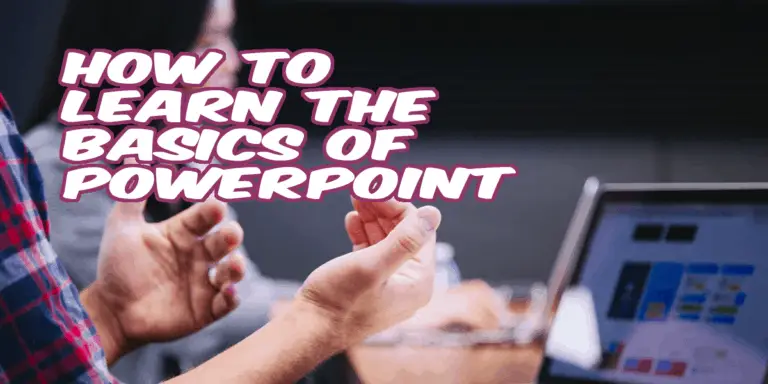
Learn the basics of PowerPoint they said? Since you’ve landed on this site, you’re most likely here to get yourself some basic PowerPoint skills. In this article, we will go through the most important areas to learn.
To learn the basics of PowerPoint, there are some basic functions and skills that you should manage. In summary, you need to deal with the following areas in order to say you know the basics of PowerPoint:
- Create a presentation
- Add and modify texts
- Add slides, tables, objects, and images
- Manage animations and transitions
- Start a slideshow
Do you think PowerPoint is difficult? Then you are not alone, for many, PowerPoint is a necessary evil that takes a lot of time. However, the fact is that anyone can learn PowerPoint and be good at it. In this article, we will talk about the basics and guide you through the most important features. Once you have mastered these you will be much faster and be able to create much nicer presentations. Here we go!
Two Tips Along the Way
Save Often: Do this by clicking File → Save, clicking on the save icon in the upper left corner, or by clicking ctrl + s (PC) cmd + s (Mac).
Undo an Action : If you happen to do something you need to undo, click the arrow at the top left, or click ctrl + z (PC), or cmd + z (Mac).

The Ribbon & Tabs in PowerPoint
Like all other Microsoft Office applications (you may have used Microsoft Word before?), there is a ribbon that contains about ten different tabs. Each tab has a variety of features that may seem overwhelming, but don’t worry about it! We will not go through all the tabs, just the most fundamental ones. Today we will talk about the most important parts that you will learn in no time!
However, here comes a brief description of all the tabs, so you have a little check on these before we delve into the details.
File: The major features of this tab are to create a new presentation, open an already existing presentation, save, print presentation, and share slide shows.
Home: Here you will find a variety of functions such as creating a new slide, changing the font and text size, and changing paragraph settings.
Insert: Here you can insert slides, tables, different types of images and illustrations, comments, links and different types of other media.
Design : Here you can be creative and choose different themes, edit layouts for slides, even get suggestions of PowerPoint on different design ideas.
Transitions: Here you can work on transitions, i.e. what happens when you go from one slide to another.
Animations : Animate different elements, maybe a text box should fly in from the right, or maybe you want different pieces of text to appear when you click the mouse (ideal for different lists).
Slide Show : Start your presentation and choose how it will appear if you have multiple monitors, for example.
Review : Use proofreading tools, choose which language you want to use, or add comments to remember something, or leave a comment to someone you work within the presentation.
View : A bit more advanced settings for working with different macros, change the presentation view, etc. This is not something you need to worry about as a basic user.
Help : This is an underrated part of PowerPoint. Here you can search for help and usually you will find answers regarding the basics of PowerPoint.
To Create a PowerPoint Presentation
Now we have created an overview of the functions in PowerPoint, and now we will apply some of these and build a basic but good presentation.
When you start PowerPoint, a menu often pops up where you get a few choices. Here you select Blank Presentation . If this menu does not show up for you, go to File , New , and then Blank Presentation .
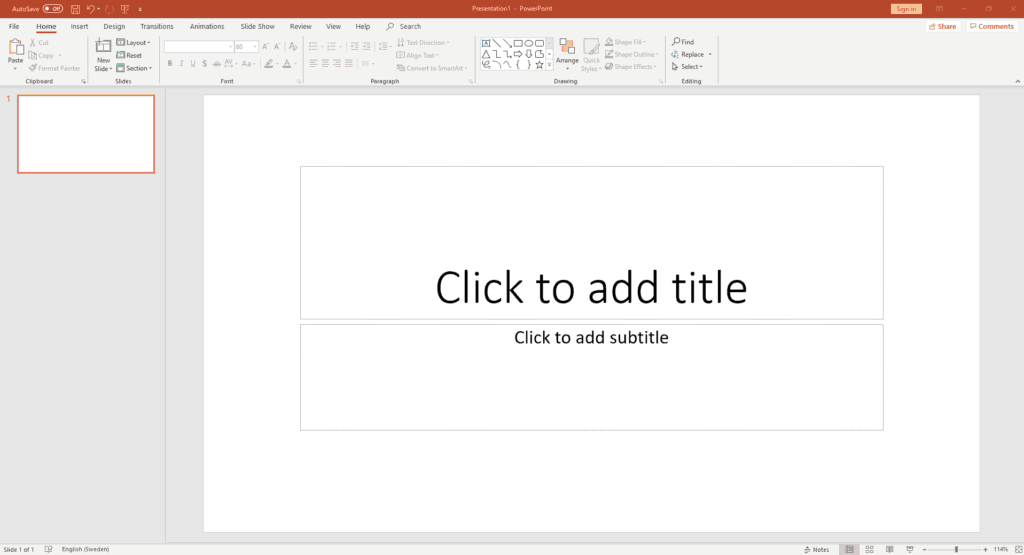
Now a new presentation has been created and in addition an empty slide. This slide can be good to use as a Title Slide , i.e. a slide where you put a heading for your presentation
Congratulations! You have now created a presentation, now it is time to fill it with content.
Create a New Slide and Fill it With Content
Sweet, you are one step closer to master the basics of PowerPoint! Now you have a new presentation and a title slide, now it’s time to create your first own slide. If you don’t already have Home Tab checked, do it. Now click on New Slide . Now you’ll see a few different designs, choose the one you think is the best or is the best suited for your purpose.
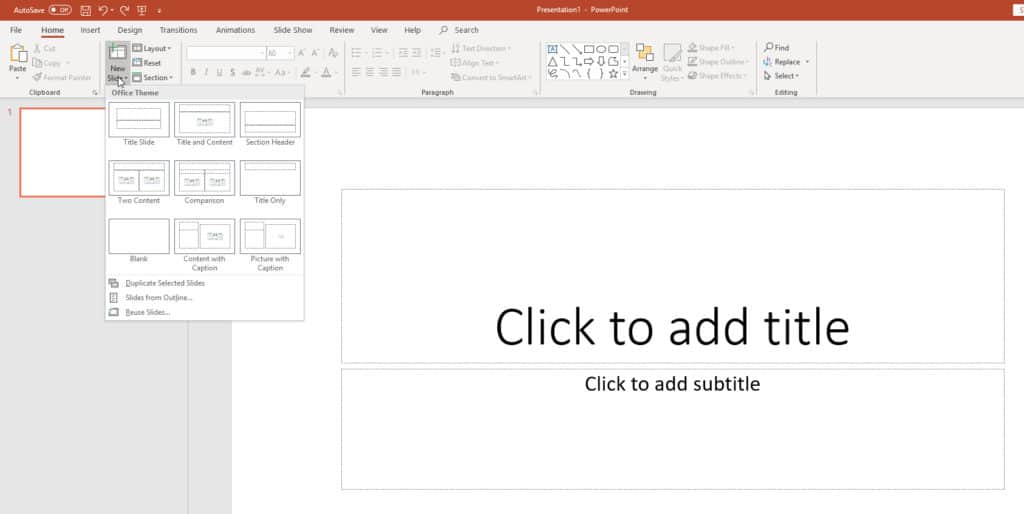
Here you can create a heading by editing the text. You can also find the Font Section and change the size and font. Remember not to use too small text as it may be difficult for some people to read.

Text Boxes & Shapes
Perfect, now you have a nice Title Slide , a brand-new Slide that you created yourself. Now it’s time to give the slide a little more life by adding its own text box and shape. Let’s start by adding a new text box.
Navigate to the Insert Tab and then look a bit to the right where you see the Text Box icon. Click it, then place the box in any place and fill it with text. Bonus Tip : if you think the text box looks boring, right-click on the box you just created, you can choose a fill color.

Now, let’s create a shape. Still, on the Insert Tab , navigate to the shapes icon and click it. Here you get a lot of different suggestions on shapes to incorporate into the presentation. Choose one that you think is stylish and place it out.
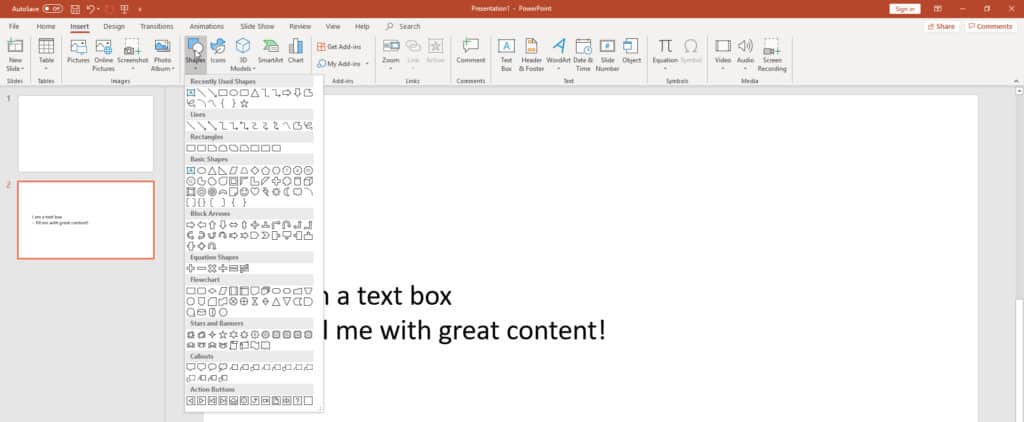
If you click on the object, you can choose to resize, rotate, or change the dimensions. The same goes for the text box if you want to change color right click on the Fill icon and select a color that you think looks good.
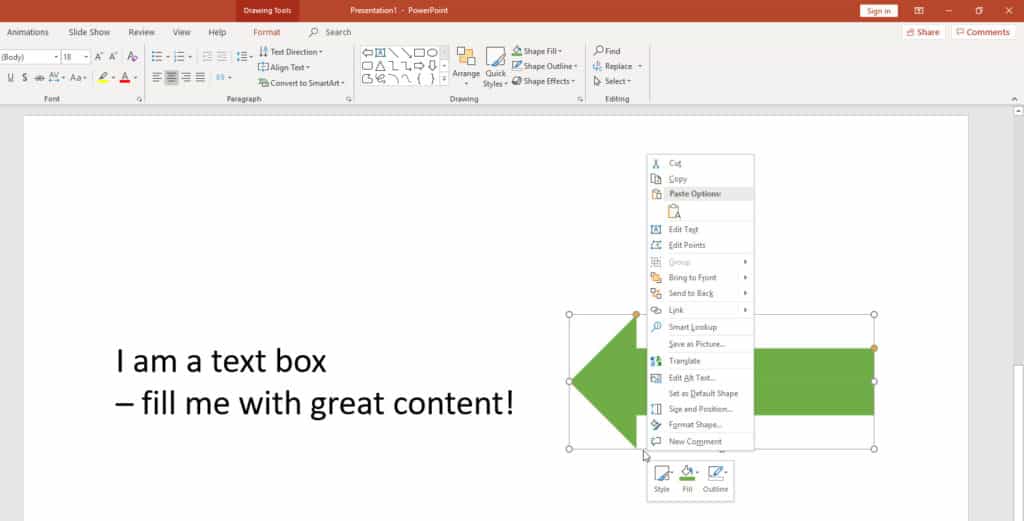

Transitions
Now it starts to look nice! If you navigate to Slide Show Tab or click F5 , you can see what the presentation will look like. You navigate between your slides with the arrow keys, space bar, or click the mouse. Test this. Surely the transitions between slides feel a little boring. Let’s fix this now!

Select the second slide, click on the Transitions tab . Here you will find a few different options for transitions, click through the different ones and choose one that you think is good. Keep in mind that different types of transitions will fit better or worse in different situations. A super cool transition with lots of effects might fit very well in the classroom, but less well at a board meeting.
Surely, we have all seen PowerPoint presentation with different objects popping up in lots of cool ways and always wondered how to do this? It’s a lot easier than you think – let’s make some animations.
We chose to insert an arrow into the slide to emphasize the text. To further emphasize this, it would have been nice if the arrow came in after the text – let’s fix this.
Navigate to the Animations Tab . Now you may notice that this looks almost the same as the Transitions Tab , it’s because it works almost the same. Instead of selecting the slide you want to create a transition to, select the object or text box that you want to animate. Click on the object you want to animate, and then test different types of animations in the Animations Pane . Choose the one that suits you best.

In my case, I use the animation called Fly In . If you look at the far left you see an icon called Preview , click on this and you can see how the animation will appear in the slide. In my case, the arrow flies in from the bottom, which doesn’t suit me so well when the arrow points to the text. However, this is easily fixed. On the right-hand side of all the animation styles, there is an icon called Effect Options . If we click on this, we can choose how the object should behave.
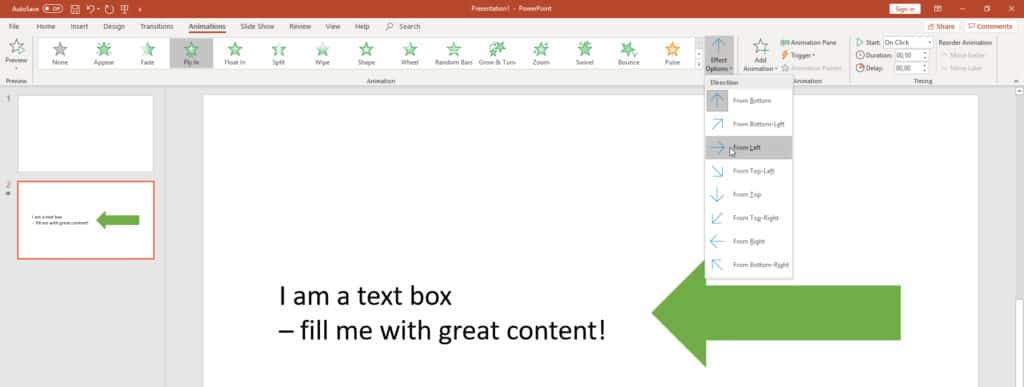
Start the Slide Show
There you go! Now we have built a basic, but very good PowerPoint slide. Now just follow the same principle for the rest of the slides you need to include in your presentation.
When you are satisfied, it is time to present. As we mentioned earlier, you can do this in slightly different ways. Among other things, you can click F5 on your keyboard or navigate to the Slide Show Tab and click From Beginning on the far left-hand side, then your nice PowerPoint presentation will start.

You have now built a PowerPoint presentation and learned the basics of PowerPoint – good job and congratulations! Getting good at PowerPoint takes a while, but practice gives skill. In fact, you will come very far with the knowledge gained from this article.
Stay tuned for more PowerPoint and presentation tips and articles and remember to post a comment and share this article if you like it. Your support is everything to us!

Did you know, you can create your own PowerPoint presentation online at Office.com

Leave a Reply Cancel Reply
Add Comment
Save my name, email, and website in this browser for the next time I comment.
Post Comment
Related Posts
How to add music to powerpoint slideshow and find free music, how to record audio in powerpoint for narration or voice-over | step-by-step, [solved] how to upload powerpoint to google drive.

- Get started with computers
- Learn Microsoft Office
- Apply for a job
- Improve my work skills
- Design nice-looking docs
- Getting Started
- Smartphones & Tablets
- Typing Tutorial
- Online Learning
- Basic Internet Skills
- Online Safety
- Social Media
- Zoom Basics
- Google Docs
- Google Sheets
- Career Planning
- Resume Writing
- Cover Letters
- Job Search and Networking
- Business Communication
- Entrepreneurship 101
- Careers without College
- Job Hunt for Today
- 3D Printing
- Freelancing 101
- Personal Finance
- Sharing Economy
- Decision-Making
- Graphic Design
- Photography
- Image Editing
- Learning WordPress
- Language Learning
- Critical Thinking
- For Educators
- Translations
- Staff Picks
- English expand_more expand_less
PowerPoint 2010 - Slide Basics
Powerpoint 2010 -, slide basics, powerpoint 2010 slide basics.

PowerPoint 2010: Slide Basics
Lesson 2: slide basics.
/en/powerpoint2010/getting-started-with-powerpoint/content/
Introduction
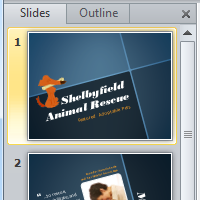
PowerPoint includes all of the features you need to produce professional-looking presentations. When you create a PowerPoint presentation, it is made up of a series of slides . The slides contain the information you want to communicate with your audience. This information can include text, pictures, charts, video, and sound. Before you begin adding information to slides, you'll need to know the basics of working with slides. In this lesson, you will learn how to insert new slides, modify a layout , and change your presentation view .
Slide basics
Every PowerPoint presentation is composed of a series of slides . To begin creating a slide show, you'll need to know the basics of working with slides. You'll need to feel comfortable with tasks such as inserting a new slide, changing the layout of a slide, arranging existing slides, changing slide view , and adding notes to a slide.
Optional: You can download this example for extra practice.
About slides
Slides contain placeholders , which are areas on the slide that are enclosed by dotted borders. Placeholders can contain many different items, including text, pictures, and charts. Some placeholders have placeholder text , or text you can replace. They also have thumbnail-sized icons that represent specific commands such as Insert Picture , Insert Chart , and Insert ClipArt . In PowerPoint, hover over each icon to see the type of content you can insert in a placeholder.

About slide layouts
Placeholders are arranged in different layouts that can be applied to existing slides or chosen when you insert a new slide . A slide layout arranges your content using different types of placeholders, depending on what information you might want to include in your presentation.
In the example above, the layout is called Title and Content and includes title and content placeholders. While each layout has a descriptive name, you can also tell from the image of the layout how the placeholders will be arranged.
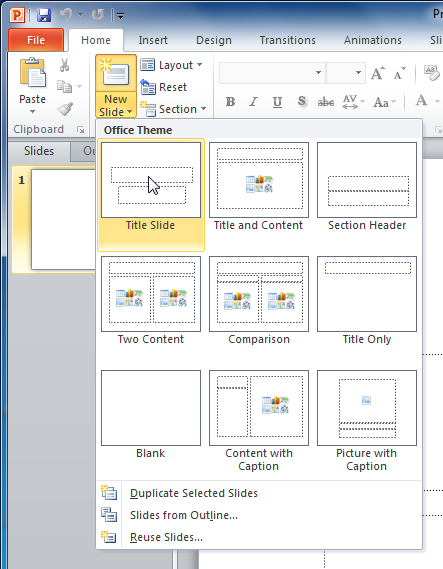
Customizing slide layouts
To change the layout of an existing slide:.
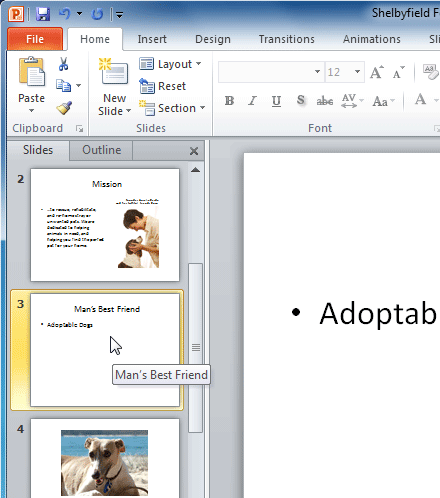
To delete a placeholder:
You can easily customize your layout by deleting unwanted—or extra—placeholders from any slide.
- Press Backspace or Delete on your keyboard. The placeholder will be removed from the slide.
To add a text box:
Text boxes allow you to add to your current layout, so you can place text wherever you want on your slide.
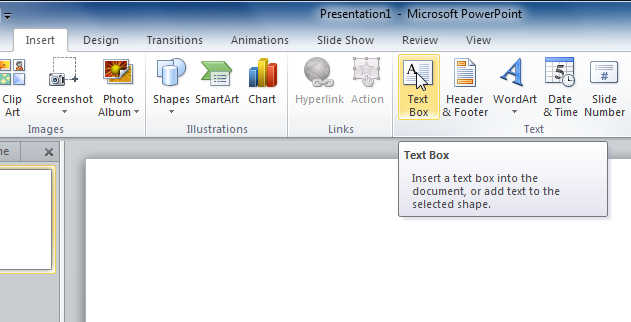
Explore our Text Basics lesson to learn more about inserting and using text boxes in PowerPoint 2010.
To use a blank slide:
For more control over your content, you may prefer a blank slide—a slide without placeholders—over one of the existing layouts. Blank slides can be customized by adding your own text boxes, pictures, charts, and more.
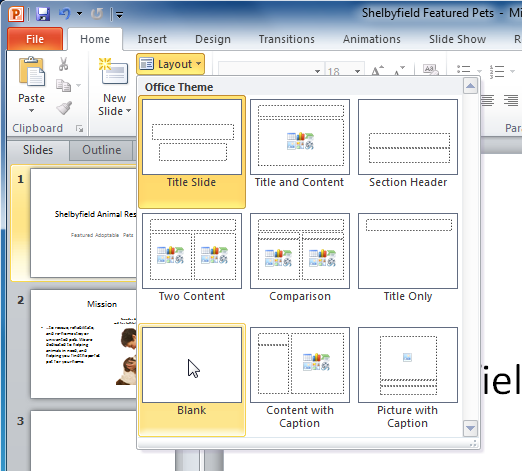
Working with slides
To insert a new slide:.
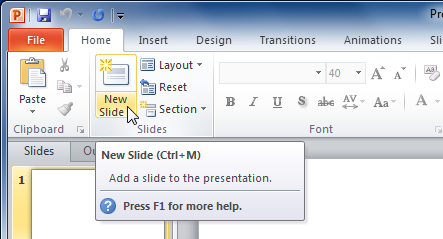
- A new slide will be added your presentation.
To instantly add a slide that uses the same layout as the one you have selected, click the top half of the New Slide command.
To copy and paste a slide:
- On the Slides tab in the left pane, select the slide you want to copy.
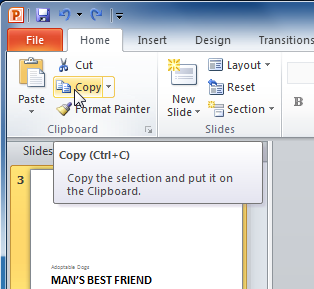
To select multiple slides, press and hold Ctrl on your keyboard and click the slides you want to select.
To duplicate a slide:
An alternative to copying and pasting, duplicating slides copies the selected slide and—in one step—pastes it directly underneath. This feature does not allow you to choose the location of the copied slide, nor does it offer Paste Options for advanced users, so it's more convenient for quickly inserting similar slides.
- Select the slide you want to duplicate.
- Click the New Slide command.
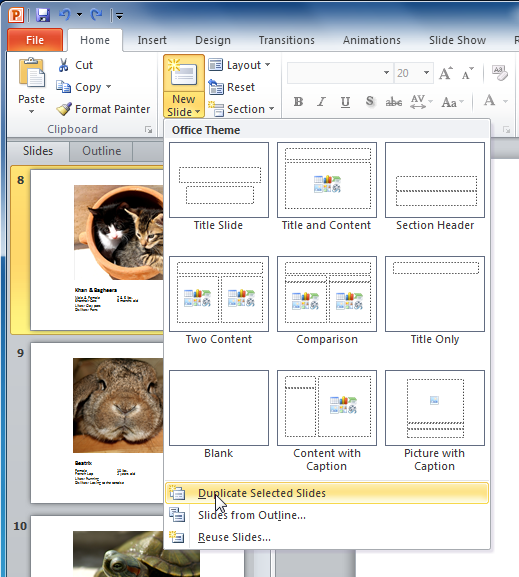
To delete a slide:
- Select the slide you want to delete.
- Press the Delete or Backspace key on your keyboard.
To move a slide:
- Select the slide you want to move.
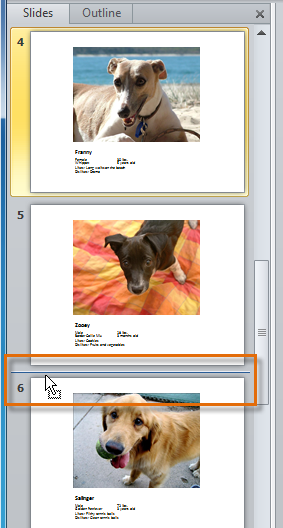
- Release the mouse button. The slide will appear in the new location.
Managing slides and presentations
As you add slides to your presentation, PowerPoint offers a variety of views and tools to help you organize and prepare your slide show.
About slide views
It's important to be able to access the different slide views and use them for various tasks. The slide view commands are located on the bottom-right of the PowerPoint window in Normal view.
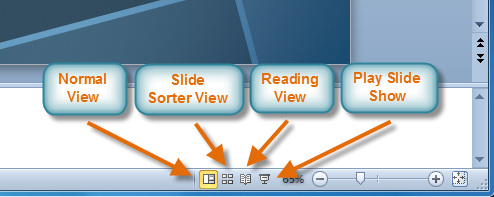
Normal view : This is the default view where you create and edit your slides. You can also move slides in the Slides tab in the pane on the left.
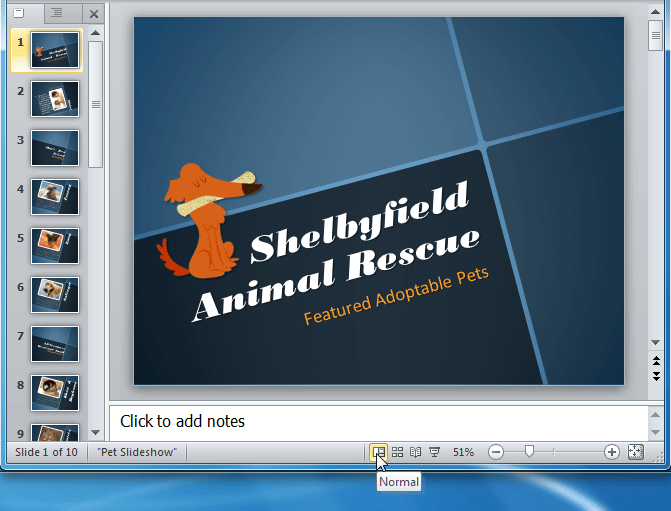
Slide Sorter view : In this view, miniature slides are arranged on the screen. You can drag and drop slides to easily reorder them and to see more slides at one time. This is a good view to use to confirm that you have all the needed slides and that none have been deleted.
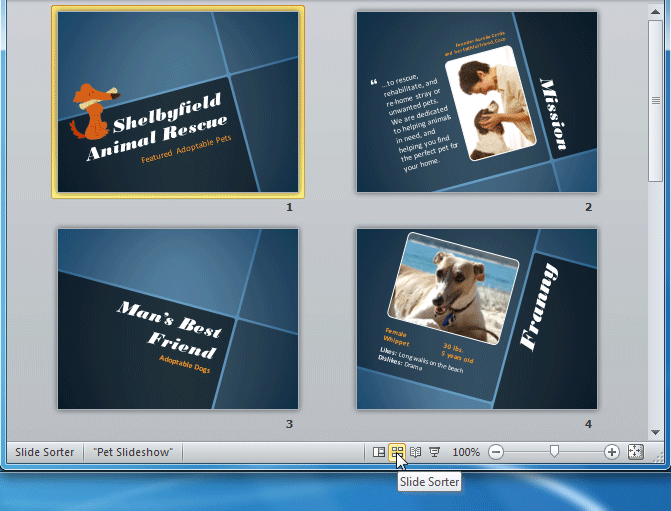
Reading view : This view fills most of the computer screen with a preview of your presentation. Unlike Slide Show view, it includes easily accessible buttons for navigation, located at the bottom-right.

Slide Show view : This view completely fills the computer screen and is what the audience will see when they view the presentation. Slide Show view has an additional menu that appears when you hover over it, allowing you to navigate slides and access other features you can use during a presentation.

Use the keys on your keyboard—including the arrow keys, Page Up and Page Down keys, spacebar, and Enter key—to move through the slides in Slide Show view. Press the Esc key to end the slide show.
To view an outline of your presentation:
The Outline tab shows your slide text in outline form. This allows you to quickly edit your slide text and view the contents of multiple slides at once.
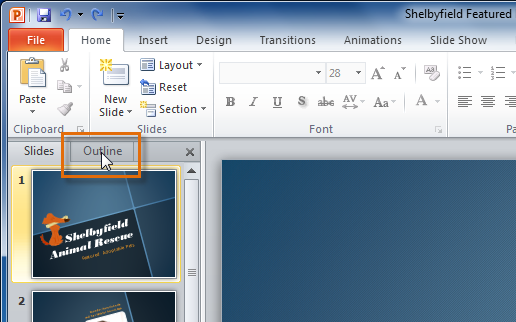
- An outline of your slide text appears.

To organize slides into sections:
You can organize your slides into sections to make your presentation easier to navigate. Sections can be collapsed or expanded in the left pane and named for easy reference. In this example, we will add two sections: one for dogs that are available for adoption, and another for cats and other pets.
- Select the slide you want to begin your first section.
- From the Home tab, click the Section command.
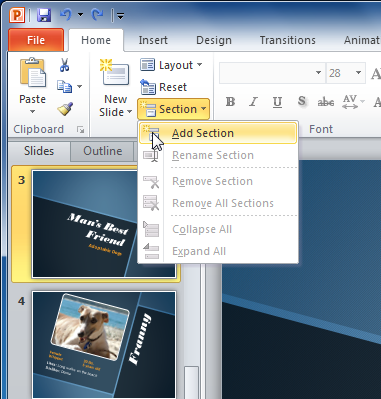
- Repeat to add as many sections as you want.
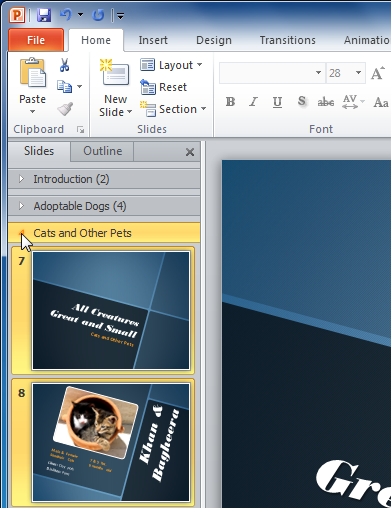
Adding notes to slides
PowerPoint gives you the ability to add notes to your slides—often called speaker notes —to help you deliver or prepare for your presentation. You can enter and view your speaker notes using the Notes pane or the Notes Page view.
To use the Notes pane:
- Locate the Notes pane at the bottom of the screen, directly below the Slide pane.
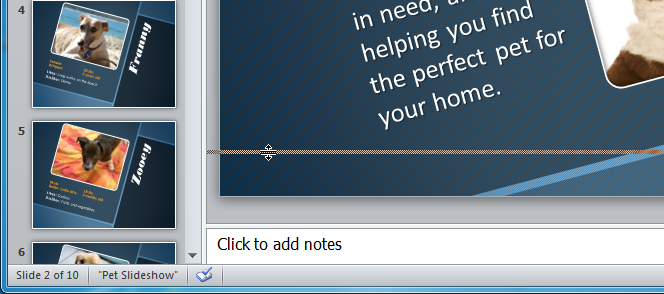
To use Notes Page view:
- Go to the View tab.
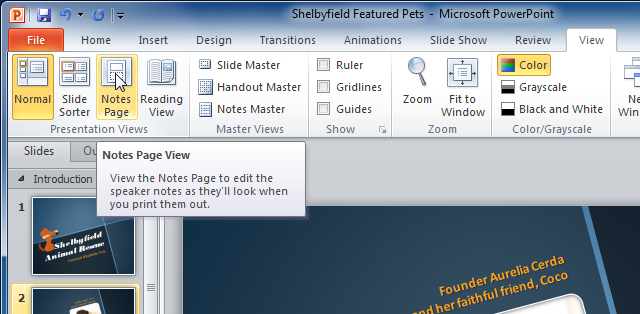
- Open an existing PowerPoint presentation . If you want, you can use this example .
- Change the layout of a slide. If you are using the example, change the layout of slide 3 to Section Header .
- Add a new blank slide, then insert a text box .
- Copy and paste a slide, then move it to a new location.
- View your presentation in Normal view, Slide Sorter view, Reading view, and Slide Show view.
- View an outline of your presentation in the left pane.
- Divide your presentation into at least two sections , and try collapsing and expanding them. If you are using the example, create one section for dogs and another for cats and other pets.
- Experiment with adding speaker notes to your presentation using the Notes pane and the Notes Page view .
/en/powerpoint2010/text-basics/content/

- Onsite training
3,000,000+ delegates
15,000+ clients
1,000+ locations
- KnowledgePass
- Log a ticket
01344203999 Available 24/7
What is PowerPoint: A Comprehensive Guide for Beginners
What is PowerPoint? This blog provides the essence of PowerPoint, a versatile presentation software by Microsoft. Discover its features, uses, and the art of crafting compelling slideshows. Whether you're a student, professional, or simply curious, explore the power of PowerPoint and learn how to create impactful presentations effortlessly.

Exclusive 40% OFF
Training Outcomes Within Your Budget!
We ensure quality, budget-alignment, and timely delivery by our expert instructors.
Share this Resource
- Microsoft Dynamics 365 Fundamentals (ERP) MB920
- Microsoft Access Training
- Microsoft Dynamics 365 Fundamentals (CRM) MB910
- Microsoft Word Course
- Microsoft Dynamics 365 Marketing MB220

According to Glassdoor , a PowerPoint designer's average salary in the UK is about £37,811 annually. In this blog, you will learn What is PowerPoint, its key features, its benefits, and how to use it, as well as learn some tips for creating effective presentations.
Table of contents
1) What is PowerPoint?
2) Understanding the PowerPoint Interface
3) Key Features of PowerPoint
4) How to use PowerPoint to create a presentation?
5) Benefits of PowerPoint
6) Tips for Creating Effective PowerPoint Presentations
7) Conclusion
What is PowerPoint?
PowerPoint is a versatile and popular presentation software developed by Microsoft (MS). It is a part of the Microsoft Office Suite and offers various features and tools to create visually appealing and engaging presentations. MS PowerPoint allows users to combine text, graphics, multimedia elements, and animations to convey information effectively .
Evolution of PowerPoint

Understanding the PowerPoint Interface
The PowerPoint interface provides a user-friendly environment for creating and editing presentations. Familiarising yourself with its essential components will help you navigate the software efficiently. Here's a breakdown of the MS PowerPoint interface:
1) Ribbon : The Ribbon is located at the top of the MS PowerPoint window and consists of multiple tabs, such as Home, Insert, Design, Transitions, and more.
2) Slides pane : The Slides pane is on the left side of the PowerPoint window. It displays thumbnail images of your presentation slides, allowing you to navigate and rearrange them easily. You can add, delete, duplicate, or hide slides from this pane.
3) Notes pane : The Notes pane is located below the Slides pane. It provides space for adding speaker notes or additional information related to each slide.
4) Slide area : The Slide area occupies the central part of the PowerPoint window. It displays the selected slide, where you can add and arrange content such as text, images, charts, and multimedia elements .
5) Task panes : Task panes are additional panels on the PowerPoint window's right side. They offer various functionalities such as formatting options, slide layouts, animations, etc. Task panes can be opened or closed based on your specific needs.
Understanding the MS PowerPoint interface will help you navigate the software effectively and make the most of its features. Whether you are creating slides, adding content, or applying formatting, having a good grasp of the interface ensures a smooth and productive experience .
Key Features of PowerPoint
When it comes to creating captivating and professional presentations, MS PowerPoint stands out as versatile and feature-rich software. Its array of tools and functionalities enables users to bring their imagination and ideas to life. Moreover, it also helps engage their audience effectively .

1) Slide Templates : PowerPoint provides a collection of pre-designed templates that make it easy to create visually appealing slides.
2) Slide Master : The Slide Master feature allows users to define the overall layout, font styles, and colour scheme for the entire presentation .
3) Animations and transitions : PowerPoint offers various animation effects and slide transitions to add visual interest and captivate the audience .
4) Multimedia integration : Users can embed images, videos, and audio files directly into their presentations, enhancing the overall impact .
5) Collaboration tools : MS PowerPoint allows multiple users to work on a presentation simultaneously, making it ideal for team projects and remote collaboration .
6) Presenter View : The Presenter View feature gives presenters access to speaker notes, a timer, and a preview of upcoming slides, enabling a seamless presentation experience .
These features collectively contribute to PowerPoint's versatility and make it a powerful tool for developing engaging and impactful presentations.
How to use PowerPoint to create a presentation?
Creating a presentation in PowerPoint is a straightforward process. Whether it's simple animations or explainer videos learning H ow to use PowerPoint is an extremely valuable skill. Here's a step-by-step guide on how to create a presentation:
1) Launch PowerPoint and choose a template or start with a blank slide.
2) Add slides by clicking "New Slide" or using the shortcut key (Ctrl + M).
3) Customise slide content by entering text and inserting visuals.
4) Rearrange slides for a logical flow by dragging them in the slide navigation pane.
5) Apply slide transitions for visual effects in the "Transitions" tab.
6) Add animations to objects in the "Animations" tab.
7) Preview your presentation by clicking "Slide Show".
8) Save your presentation and choose a format (.pptx or .pdf).
9) Share your presentation via email, cloud storage, or collaboration tools.
By following these steps, you can create a well-structured and visually appealing presentation in Microsoft PowerPoint. Remember to keep your content concise, use engaging visuals, and practice your presentation skills to deliver an impactful presentation .
Benefits of PowerPoint

1) Visual appeal : Microsoft PowerPoint allows you to create visually appealing presentations with its wide range of design tools and features. You can use templates, themes, and customisable layouts to make your slides visually engaging and professional .
2) Easy to use : PowerPoint has a user-friendly interface, making it accessible to users of all levels. The intuitive tools and straightforward navigation make it easy to create, edit, and deliver presentations efficiently .
3) Flexibility : PowerPoint provides flexibility in terms of content creation. You can include various types of content, such as text, images, charts, graphs, videos, and audio files, to enhance your message and engage your audience effectively.
4) Organisation and structure : PowerPoint offers features to help you organise and structure your content. You can create multiple slides, use slide masters for consistent formatting, and arrange the sequence of slides to create a logical flow .
5) Presenter tools : PowerPoint includes built-in presenter tools that aid in delivering presentations smoothly. You can use presenter view to see your notes and upcoming slides while your audience sees only the presentation. Additionally, features like slide transitions and animations add visual interest and help you control the flow of information .
6) Collaboration and sharing : PowerPoint allows for easy collaboration and sharing of presentations. Several users can simultaneously work on the same presentation, making it convenient for team projects. You can also share your presentations via email, cloud storage, or online platforms, ensuring easy access for viewers .
7) Integration with other tools : PowerPoint can seamlessly integrate with other Microsoft Office applications, such as Word and Excel. You can import data and charts from Excel or copy and paste content between different Office applications, saving time and effort .
8) Presenter-audience interaction : PowerPoint provides features that facilitate interaction between the presenter and the audience. You can include interactive elements like hyperlinks, buttons, and quizzes to engage your audience and make your presentations more dynamic.
9) Portable and accessible : PowerPoint presentations can be saved in various formats, such as .pptx or .pdf, making them easily accessible on different devices. This portability allows you to deliver presentations on laptops, tablets, or even projectors without compatibility issues .
10) Time and effort savings : PowerPoint simplifies the process of creating presentations, saving you time and effort. The pre-designed templates, slide layouts, and formatting options enable you to create professional-looking presentations efficiently .
Unleash your creativity to deliver captivating presentations that leave a lasting impact with our Microsoft PowerPoint Masterclass – Sign up now!
Tips for Creating Effective PowerPoint Presentations

1) Simplicity is key : Keep your slides clean and uncluttered. Use concise bullet points and simple visuals to convey your message effectively .
2) Visuals matter : Incorporate relevant, high-quality visuals such as images, charts, and diagrams to enhance understanding and engagement .
3) Limit text : Avoid overwhelming your audience with excessive text on slides. Use brief phrases or keywords to communicate key points .
4) Choose legible fonts : Opt for clear and readable fonts that are easy to read, even from a distance. Maintain consistency in font styles throughout your presentation .
5) Consistent design : Maintain a consistent design theme, including colours, fonts, and layout, to create a visually appealing and professional presentation.
6) Emphasise important points : Use visual hierarchy techniques, such as font size, colour, and formatting, to draw attention to essential information .
7) Use transitions and animations sparingly : Incorporate slide transitions and animations thoughtfully, focusing on enhancing content and transitions without distracting the audience .
8) S lide notes for guidance : Utilise the slide notes feature to include additional details, explanations, or reminders for a well-prepared and confident presentation.
9) Practice and time yourself : Rehearse your presentation to ensure smooth delivery and stay within the allocated time. Practice helps you refine your content and delivery.
10) Engage the audience : Encourage audience participation through interactive elements, questions, or discussions to foster engagement and make your presentation more memorable.
By implementing these tips, you can create effective MS PowerPoint presentations that capture attention, communicate information clearly, and engage your audience effectively.
Conclusion
We hope this blog has helped you understand What is PowerPoint and how it can help you. It offers powerful features with a user-friendly interface for creating visually appealing presentations. With its tools for organising information, incorporating text and visuals, and delivering impactful content, PowerPoint is a valuable tool for beginners to communicate their ideas effectively .
Master the art of effective communication and productivity and unlock your potential with our comprehensive Microsoft Office Training – Sign up now!
Frequently Asked Questions
Upcoming office applications resources batches & dates.
Thu 16th May 2024
Thu 6th Jun 2024
Thu 4th Jul 2024
Thu 8th Aug 2024
Thu 5th Sep 2024
Thu 10th Oct 2024
Thu 7th Nov 2024
Thu 5th Dec 2024
Get A Quote
WHO WILL BE FUNDING THE COURSE?
My employer
By submitting your details you agree to be contacted in order to respond to your enquiry
- Business Analysis
- Lean Six Sigma Certification
Share this course
Our biggest spring sale.

We cannot process your enquiry without contacting you, please tick to confirm your consent to us for contacting you about your enquiry.
By submitting your details you agree to be contacted in order to respond to your enquiry.
We may not have the course you’re looking for. If you enquire or give us a call on 01344203999 and speak to our training experts, we may still be able to help with your training requirements.
Or select from our popular topics
- ITIL® Certification
- Scrum Certification
- Change Management Certification
- Business Analysis Courses
- Microsoft Azure Certification
- Microsoft Excel Courses
- Microsoft Project
- Explore more courses
Press esc to close
Fill out your contact details below and our training experts will be in touch.
Fill out your contact details below
Thank you for your enquiry!
One of our training experts will be in touch shortly to go over your training requirements.
Back to Course Information
Fill out your contact details below so we can get in touch with you regarding your training requirements.
* WHO WILL BE FUNDING THE COURSE?
Preferred Contact Method
No preference
Back to course information
Fill out your training details below
Fill out your training details below so we have a better idea of what your training requirements are.
HOW MANY DELEGATES NEED TRAINING?
HOW DO YOU WANT THE COURSE DELIVERED?
Online Instructor-led
Online Self-paced
WHEN WOULD YOU LIKE TO TAKE THIS COURSE?
Next 2 - 4 months
WHAT IS YOUR REASON FOR ENQUIRING?
Looking for some information
Looking for a discount
I want to book but have questions
One of our training experts will be in touch shortly to go overy your training requirements.
Your privacy & cookies!
Like many websites we use cookies. We care about your data and experience, so to give you the best possible experience using our site, we store a very limited amount of your data. Continuing to use this site or clicking “Accept & close” means that you agree to our use of cookies. Learn more about our privacy policy and cookie policy cookie policy .
We use cookies that are essential for our site to work. Please visit our cookie policy for more information. To accept all cookies click 'Accept & close'.
Microsoft PowerPoint MCQs
What is the basic unit of a powerpoint presentation.
Correct Answer: a slide
Explanation:
Note: This Question is unanswered, help us to find answer for this one
Microsoft PowerPoint Skill Assessment
Your Skill Level: Poor
Retake Quizzes to improve it
More Microsoft PowerPoint MCQ Questions
You inserted a photo and it is covering the words on a slide. How do you adjust it so that you can see the words?
What do end-users need to run your presentation?
The maximum number of Slide Masters for one slide show is:
To adjust the font size of a graph legend within Powerpoint:
The cycle category of SmartArt has the characteristic of:
Nitrifying bacteria convert _____ to _____
Using the____, you can choose the arrangement of placeholders on a new slide.
The major difference between hlookup and vlookup functions is the way the lookup tables are _____.
Once you have created a table, the ____ tab appears on the ribbon.
Powerpoint uses ____ to create numerical charts
Join our newsletter for the latest updates.

Our Products
© Copyrights 2024 Quizack.com
Flashcard Machine - create, study and share online flash cards
My flashcards, flashcard library.
Create Account
- Flashcards >>
- Computer Science >>
- PowerPoint ch. 1
Shared Flashcard Set
Cards return to set details.
- Collaborative Sets
- Study Sessions
- Flashcard Pages
- About FlashcardMachine
- Support Form
- Privacy Policy
- Terms of Use
- Getting Started
- Apple App Store
- Google Play
- Amazon Apps
Got any suggestions?
We want to hear from you! Send us a message and help improve Slidesgo
Top searches
Trending searches

46 templates

suicide prevention
8 templates

18 templates

41 templates

cybersecurity
6 templates
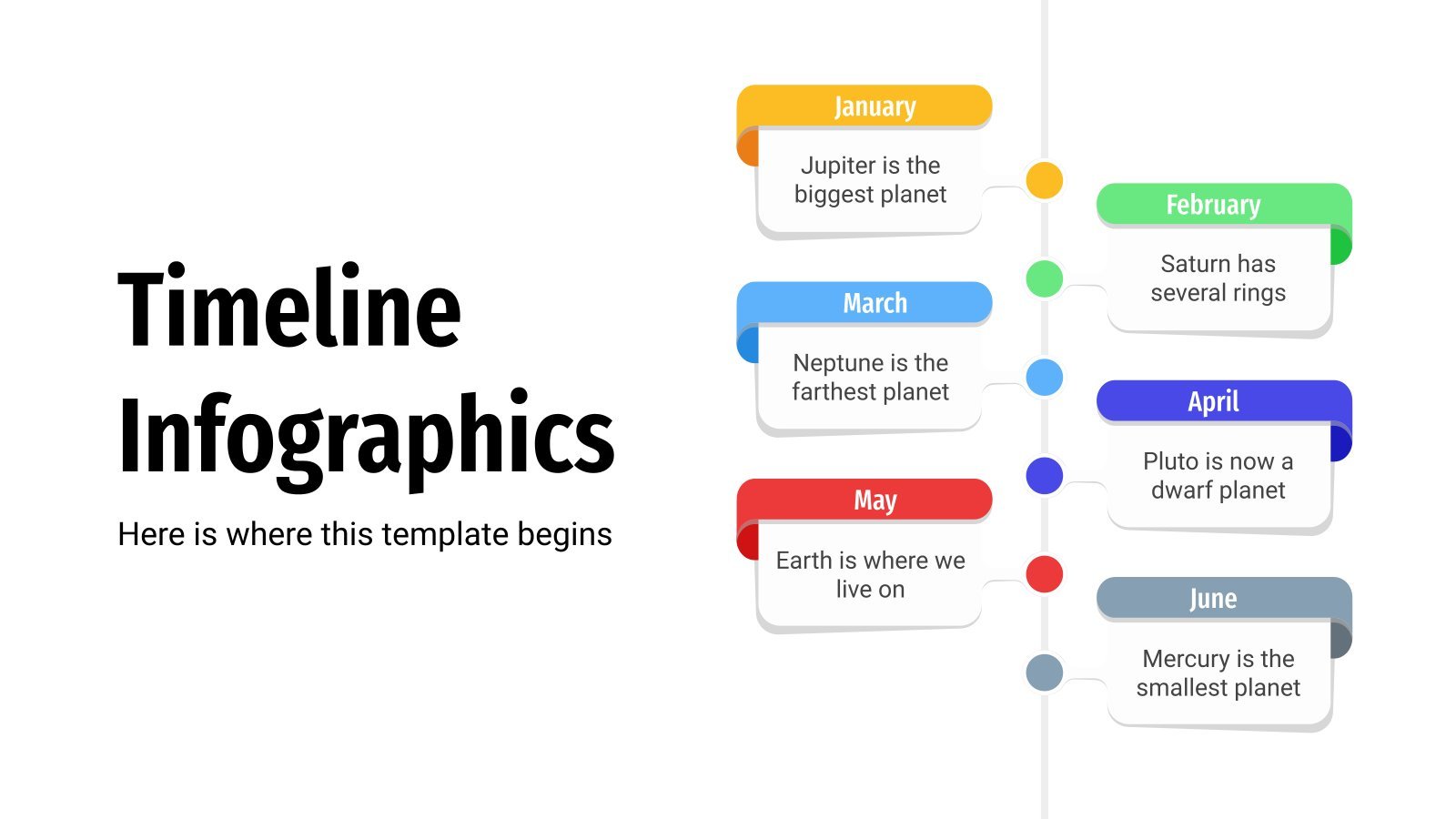
28 templates
Units of Measurement
Units of measurement presentation, free google slides theme and powerpoint template.
Who invented measurements? Why is a minute divided in 60 seconds and a liter in 100ml? This template already includes these answers, as it has been created by a professional pedagogist in collaboration with our design team. Speak about units of measurement and prepare some exercises to test your student’s knowledge with this creative template for math lessons. The content is available in different languages, but units of measurement are international (…unless you’re in the US).
Features of this template
- Designed for teachers and parents
- 100% editable and easy to modify
- 21 different slides to impress your audience
- Contains easy-to-edit graphics such as graphs, maps, tables, timelines and mockups
- Includes 500+ icons and Flaticon’s extension for customizing your slides
- Designed to be used in Google Slides and Microsoft PowerPoint
- 16:9 widescreen format suitable for all types of screens
- Includes information about fonts, colors, and credits of the resources used
- Available in different languages
How can I use the template?
Am I free to use the templates?
How to attribute?
Attribution required If you are a free user, you must attribute Slidesgo by keeping the slide where the credits appear. How to attribute?
Available in, related posts on our blog.

How to Add, Duplicate, Move, Delete or Hide Slides in Google Slides

How to Change Layouts in PowerPoint

How to Change the Slide Size in Google Slides
Related presentations.
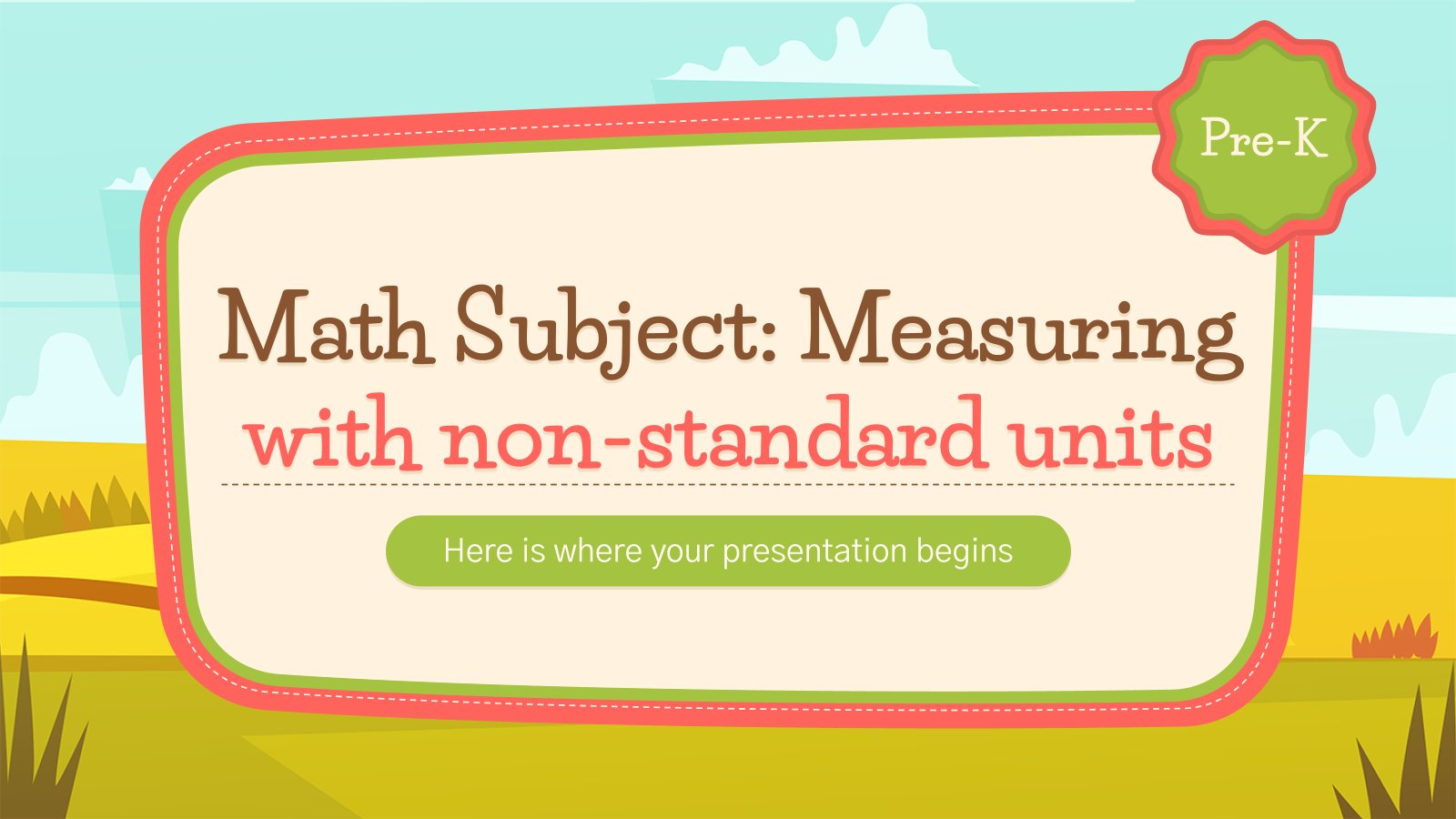
Premium template
Unlock this template and gain unlimited access

Register for free and start editing online
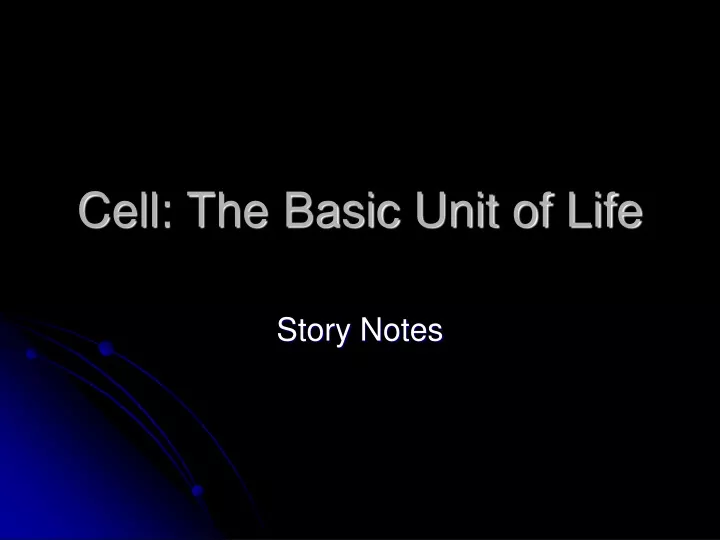
Cell: The Basic Unit of Life
Jan 05, 2020
100 likes | 175 Views
Cell: The Basic Unit of Life. Story Notes. Introduction and What is A Cell?. Everything is composed of living cells.
Share Presentation
- prokaryotic cells
- organized structures
- eukaryotic cells
- organized structures inside

Presentation Transcript
Cell: The Basic Unit of Life Story Notes
Introduction and What is A Cell? • Everything is composed of living cells. • Cells are chemical factories that use energy from food, take in raw materials, produce and exchange gases, grow, need water, eliminate waste materials, and reproduce themselves.
Prokaryotic Cells • Prokaryotic cells are those without a nucleus that live alone as single celled organisms. • Bacteria are single celled organisms from the kingdom Monera. • Bacteria are filled with cell liquid, cytoplasm, but don’t have organized internal structures. • Some bacteria get energy by producing their own food through photosynthesis. • Others take and soak up chemicals from the environment. • Prokaryotic cells have cytoplasm, cell membrane, cell wall (some), and ribosomes.
A Cell With A Nucleus • Eukaryotic cells have organized structures inside the cell including a cell nucleus which directs the activities of the cell. • Organelles, the organized structures inside the cell, have specific jobs to perform. • The structures inside are the nucleus, chloroplast, mitochondrion, cell wall (some), cytoplasm, cell membrane, endoplasmic reticulum, ribosomes, and vacuoles. • Protista live in water but are more complex and bigger than bacteria. • Plant, animals, and all other cells except bacteria are eukaryotic cells.
Cells Invade the Land and Aquatic Life on Dry Land • To keep cells alive, organisms that live out of water have ways to keep their cells wet. • The cell wall helps to hold water inside the cell. • The water supply is refreshed by drinking liquids and eating foods that contain water. • Life can be considered aquatic because life happens in our cells. All cells are aquatic and are in constant contact with our blood.
CELLS • Prokaryotic Cells- cells without a nucleus that live as single celled organisms • Bacteria are prokaryotic • Eukaryotic Cells- have a nucleus and other organized structures • Plants, animals, and all other cells besides bacteria are eukaryotic
All life is considered aquatic because life happens in cells and all cells need water to survive.
Vocabulary • Cytoplasm- liquid all cells are filled with • Photosynthesis- process of producing own food • Monera- bacteria are single celled organisms from this kingdom • Protista- live in water, but are more complex and bigger than bacteria
Cell Wall- helps hold water inside the cell • Nucleus- the “brain” of the cell • Mitochondria- place where energy production occurs
The only parts that are in both prokaryotic and eukaryotic cells are cell membrane, cytoplasm, and ribosomes.
- More by User

Cell Organelles
Cell Organelles. Eukaryotic Cells. Cell Parts. Cells – the basic unit of life Organelles - small structures inside a cell with specific functions. Analogy – City of Rocklin. A) Cell Membrane/Plasma Membrane . Cell membrane.
692 views • 21 slides

Chapter 4. The Cell: Basic Unit of Life
474 views • 33 slides
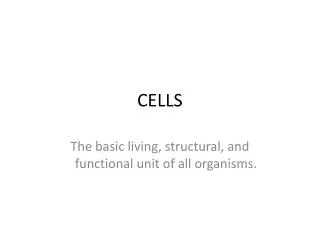
CELLS. The basic living, structural, and functional unit of all organisms. Basic Cell Structure. Cell (Plasma) Membrane Cytosol Organelles Nucleus. Basic Cell. Basic Cell Structures. Cytosol. The semi-fluid component of cytoplasm or intracellular fluid 75% - 95% water
986 views • 65 slides

Cell Structure Chapter 7
Cell Structure Chapter 7. Section 1—Introduction to Cells Section 2—Inside the Eukaryotic Cell Section 3—From Cell to Organism. Introduction to Cells. Why it Matters Cells are the basic unit of life. By studying cells, biologist can better understand life’s processes.
755 views • 64 slides
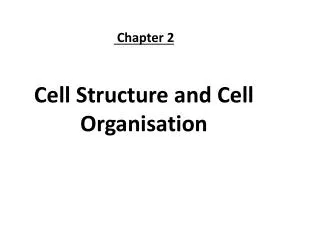
Chapter 2 Cell Structure and Cell Organisation
Chapter 2 Cell Structure and Cell Organisation. Unicellular. A single cell performs all the basic life process. Example: Amoeba sp. , Paramecium sp. Multicellular. An organism consists of more than one cell . Each group of cell specialized to carry our life processes.
455 views • 22 slides

CELLS. CELLS. box-like shapes building blocks of life come in different types and sizes Basic unit of living thing. TWO MAIN TYPES OF CELLS. Animal Cell Plant Cell. ORGANELLES. parts that make up a cell each does a separate job inside the cell. BACTERIAL CELL. simplest type of cell
313 views • 14 slides
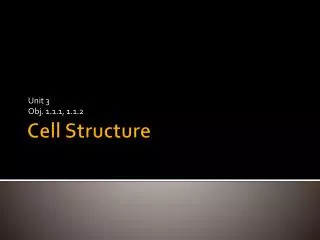
Cell Structure
Unit 3 Obj. 1.1.1, 1.1.2. Cell Structure. What is a cell?. The basic unit of life Discovered in 1665 by Robert Hooke He thought they looked like the rooms monks lived in, so he called them “cells”. Cell History Continued.
497 views • 36 slides

The Cell Theory
The Cell Theory. A. All living organisms are made up of one or more cells B. The cell is the basic unit of life C. All cells come from the division of pre-existing cells. Head Lice. Hands and Claws of a Housefly. marine polychaete worm, Nereis . Wasp. Pollen. Trypanosome.
1.06k views • 88 slides
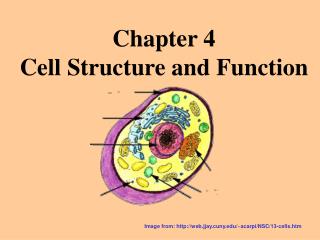
Chapter 4 Cell Structure and Function
Chapter 4 Cell Structure and Function. Image from: http://web.jjay.cuny.edu/~acarpi/NSC/13-cells.htm. CELL THEORY. 1. All living things are made of cells. 2. The cell is the basic unit of structure and function in living things. (CELL= the basic unit of life).
866 views • 65 slides
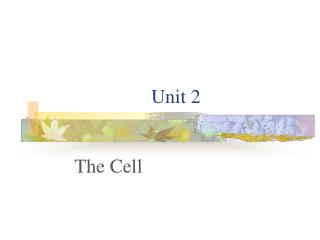
Unit 2. The Cell. The cell is: the most basic structural and functional unit of life. the smallest structure capable of carrying on all vital life functions. I. Cell Structure and Function. A. Plasma (cytoplasmic) membrane Envelopes the cell
1.3k views • 110 slides
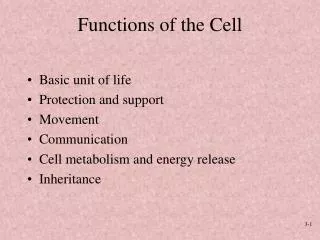
Functions of the Cell
Functions of the Cell. Basic unit of life Protection and support Movement Communication Cell metabolism and energy release Inheritance. Cell Characteristics. Plasma Membrane Outer cell boundary Substances inside the cell membrane are intracellular
762 views • 49 slides
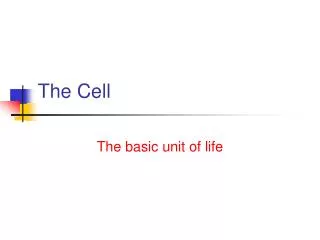
The Cell. The basic unit of life. TAKS. Objective 2 – The student will demonstrate an understanding of living systems and the environment. TEKS Science Concepts.
479 views • 39 slides

2 nd Nine Weeks
2 nd Nine Weeks. Vocabulary Review. 100 Points. Basic unit of all life. Answer: Cell. 100 Points. Flexible structure that holds the cell together, forms a boundary between the cell and the environment. Answer: cell membrane. 100 Points.
565 views • 49 slides
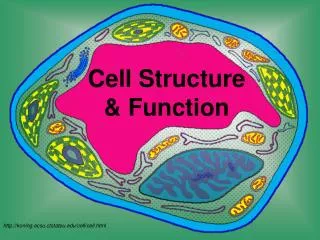
Cell Structure & Function
Cell Structure & Function. http://koning.ecsu.ctstateu.edu/cell/cell.html. Cell Theory. All organisms are made of one or more cells. Cells are the basic unit of life in all living things. All cells come from existing cells. Definition of Cell.
473 views • 24 slides

Cell Structure and Function
Cell Structure and Function. Chapter 5. Cell Theory. Every organism is composed of one or more cells Cell is smallest unit having properties of life Life arises from growth and division of single cells (cells come from pre-existing cells). Cell. Smallest unit of life
727 views • 51 slides
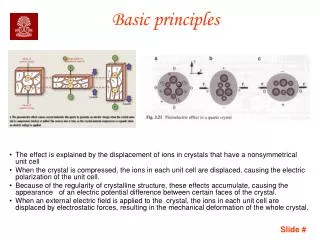
Basic principles
The effect is explained by the displacement of ions in crystals that have a nonsymmetrical unit cell When the crystal is compressed, the ions in each unit cell are displaced, causing the electric polarization of the unit cell.
305 views • 6 slides

Inside a Cell
Inside a Cell. http://www.brainpop.com/science/plantsandanimals/cellstructures/index.weml?&tried_cookie=true. Cell. The cell is the basic unit of life. The cell is made-up of small structures called organelles. Organelles carry out the life function and processes of the cell
255 views • 10 slides
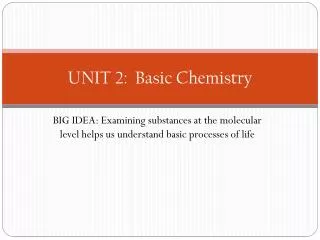
UNIT 2: Basic Chemistry
UNIT 2: Basic Chemistry. BIG IDEA: Examining substances at the molecular level helps us understand basic processes of life. Basic Chemistry. Living and non living things are all made of the same basic building blocks of matter Basic life processes all follow the laws of chemistry
1.35k views • 59 slides
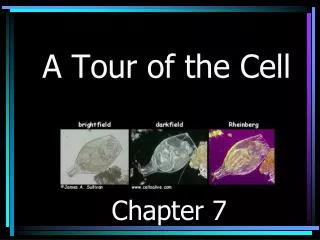
A Tour of the Cell
A Tour of the Cell. Chapter 7. All Organisms are Made of Cells. 7.1. Cell. Basic unit of life. Robert Hook. Found the first cell 1665. Anton Van Leuwenhoek. Invented the microscope 1673. The Cell Theory. 1. All living things are made up of cells.
623 views • 51 slides
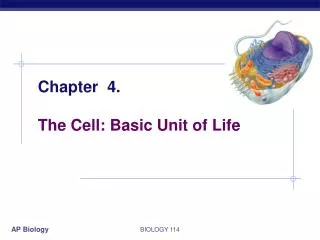
Chapter 4. The Cell: Basic Unit of Life. Why do we study cells?. Cell Theory. All organisms are made up of cells The cell is the basic living unit of organization for all organisms All cells come from pre-existing cells. Biological diversity & unity.
498 views • 33 slides

Introduction to Basic Histology
Introduction to Basic Histology. Ms. Hazel Anne L. Tabo. Level of Organization. Cell – most basic unit structure of life. Unicellular life forms – perform and carry out life processes
773 views • 25 slides

IMAGES
VIDEO
COMMENTS
One of the basics of PowerPoint presentations is to have a consistent color palette throughout. With these PowerPoint basics covered, let's change the slide background color on slide two. To start, click on the slide background. Next, click on the Design tab. In the toolbar, click on the Format Background button.
A____ is a basic unit of a PowerPoint presentation. Layouts. ____ are used to position the content on a slide. scroll arrow. used with a mouse to shift the on-screen display up and down or left and right. Ribbon. the toolbar at the top of the screen that executes commands with tabs. Key Tip.
Figure 1. PowerPoint's Normal view includes most of the information you need to assemble a presentation. [View full size image] A fully loaded slide (see Figure 2) includes at most six parts: Figure 2. All the components of a PowerPoint slide are shown here, with slide thumbnails in place of a text outline.
To do that, simply go up to the Home tab and click on New Slide. This inserts a new slide in your presentation right after the one you were on. You can alternatively hit Ctrl+M on your keyboard to insert a new blank slide in PowerPoint. To learn more about this shortcut, see my guide on using Ctrl+M in PowerPoint.
Microsoft PowerPoint is a presentation design software that is part of Microsoft 365. This software allows you to design presentations by combining text, images, graphics, video, and animation on slides in a simple and intuitive way. Over time, PowerPoint has evolved and improved its accessibility to users.
Select the text. Under Drawing Tools, choose Format. Do one of the following: To change the color of your text, choose Text Fill, and then choose a color. To change the outline color of your text, choose Text Outline, and then choose a color. To apply a shadow, reflection, glow, bevel, 3-D rotation, a transform, choose Text Effects, and then ...
From the Home tab, click the bottom half of the New Slide command. Choose the desired slide layout from the menu that appears. The new slide will appear. Click any placeholder and begin typing to add text. You can also click an icon to add other types of content, like a picture or chart.
Click once and the notes area will open up. Next, copy and paste your pre-written text from your document into the area that says, "Click to add notes.". To see the text and edit it, first click on the View tab on the top toolbar. Then in the Presentation Views grouping, select Notes Page.
To learn the basics of PowerPoint, there are some basic functions and skills that you should manage. In summary, you need to deal with the following areas in order to say you know the basics of PowerPoint: Create a presentation. Add and modify texts. Add slides, tables, objects, and images. Manage animations and transitions.
Slide basics. Every PowerPoint presentation is composed of a series of slides. To begin creating a slide show, you'll need to know the basics of working with slides. You'll need to feel comfortable with tasks such as inserting a new slide, changing the layout of a slide, arranging existing slides, changing slide view, and adding notes to a slide.
PowerPoint is a versatile and popular presentation software developed by Microsoft (MS). It is a part of the Microsoft Office Suite and offers various features and tools to create visually appealing and engaging presentations. MS PowerPoint allows users to combine text, graphics, multimedia elements, and animations to convey information ...
PowerPoint Basics . Microsoft PowerPoint is an electronic presentation program that helps people present a speech using a collection of slides. A PowerPoint presentation is a collection of slides that can be used to create oral presentations. This is the standard first sli de of a PowerPoint presentation: Inserting a New Slide . Home << New Slide
more. This class covers the essentials of using PowerPoint, including getting started, adding slides, adding text and pictures to slides, changing the look of your presentation, and presenting, saving, and printing your PowerPoint slideshow. Getting Started 1. Click the start button in the task bar at the bottom of the screen 2. Select PowerPoint
Presentations 101: The Absolute Basics of Making a Presentation. This post is part of a series called Presentation Fundamentals. Presentations don't require PowerPoint, Keynote, or any specific app. They don't require a projector, a laser pointer, or a long stick. And they definitely don't require bullet points, animations, and soundtracks.
The basic unit of a PowerPoint presentation. Layouts. Are used to position this content on the slide. Title Slide. Default when you open a new presentation. Landscape Orientation. Slide width is greater than its height. Placeholders. Boxes with dotted or hatch-marked borders that are displayed when you create a new slide.
More Microsoft PowerPoint MCQ Questions. What is the basic unit of a PowerPoint presentation? 1.object, 2.a slide, 3.presentation box, 4.task pane, 5.placeholder.
The basic unit of any PowerPoint presentation is a(n) _____. Definition. Slide: Term. ... When a new slide is added to a presentation, PowerPoint keeps the same layout used on the previous slide. (T or F) Definition. True: Term. Slides cannot be duplicated. (T or F) Definition. False: Term.
This unit covers only the basic functions of the PowerPoint. After reading through this unit, you will be able to: ... PowerPoint presentations are widely used to demonstrate profile of company, sales promotion, propagate ideas and concepts etc. The presentation only displays main points. It does not fit to
The basic unit of any PowerPoint presentation is a(n) _____. database management. All of the following are PowerPoint features except _____. word processing. The _____ feature in PowerPoint allows you to create bulleted lists, combine words and images, find and replace text, and use multiple fonts and type sizes.
This template already includes these answers, as it has been created by a professional pedagogist in collaboration with our design team. Speak about units of measurement and prepare some exercises to test your student's knowledge with this creative template for math lessons. The content is available in different languages, but units of ...
Cell is the Basic Unit of Life. The word cell is derived from the Latin word "cellula" which means "a little room" It was the British botanist Robert Hooke who, in 1664, while examining a slice of bottle cork under a microscope, found its structure resembling the box-like living quarters of the monks in a monastery, and coined the word ...
Chapter 3 Cells : The Basic Units of Life. Chapter 3 Cells : The Basic Units of Life. 5 Levels of Organization of All Living Things. 1. Cells - the basic unit of life 2. Tissues - cells working together ( muscles, nerves, blood) 3. Organs - tissues working together ( heart, kidneys, stomach, skin ) 1.57k views • 19 slides
All cells are aquatic and are in constant contact with our blood. All life is considered aquatic because life happens in cells and all cells need water to survive. The only parts that are in both prokaryotic and eukaryotic cells are cell membrane, cytoplasm, and ribosomes. Cell: The Basic Unit of Life. Story Notes.